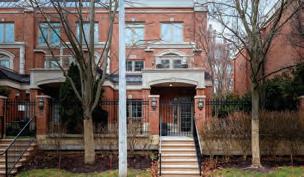SHOWER POWER T.O.’s TV WEATHER PEOPLE (& DOG!) TAKE JEANNE BEKER’S FAVOURITE RAIN GEAR FOR A SPIN



SHOWER POWER T.O.’s TV WEATHER PEOPLE (& DOG!) TAKE JEANNE BEKER’S FAVOURITE RAIN GEAR FOR A SPIN


An unscripted & unrehearsed discussion with nine housing experts on the city’s favourite spring topic
THE DESIGNER THE DEVELOPER THE CONDO KING THE BROKER THE INFLUENCER THE BANKER THE HGTV STAR THE SALES PRO




































Find out what every investor and homeowner needs to know to navigate the GTA’s spring real estate market 25
Toronto's top meteorologists (and Storm the weather dog!) take Jeanne Beker's favourite spring rain gear for a spin 43
Canada’s first lady of musical theatre, Louise Pitre on finding her leading man and their onstage meet-cute 47
French-born chef Nadège Nourian and Michelin-recognized Anthony Rose search for the city’s most authentic salad niçoise 53









tionav ds|Reno
k4ra e P cnerwaL UN
1 7k2ra n P ottyL
More and more 2 3k1ra n P ottyL
T NDER C
re choosing Andon
r R oja - M serkCcinni 4 D 4
n oitavone - R dvl n B otty L
noitidd A /A snoitidd o A w Tw /one ION T / dditionss|A
Toronto homeowners a w B e . - N n A riacnelG
6 H k1ra n P ottyL
1 8k1ra n P ottyL
i 5 R l - 3 t H seroF
cnrewaL/egn o Yo
cnerwaL/egn o Yo e
cnrewaL/egn o Yo e
rappehS/egn o Yo
w B eNev n A walria2 F- 7 dliu w Be . - N r l D e H liu w B e - N w A eivnelG a voner RojaMtrSeht ea
e .Nev Av ladkoor 2 B 7- 1
s - thgieu r HomrA e cnerwaL/egn o Yo e
rappehS/egn o Yo d
8 E k4ra n P ottyL y Y Y Y Y Y Y Ail 8D
u w Be - N e A bmocegd e A
we . - N d t R serofnel 7 G - 8
a vone- R dr Reer 67 G - 2
w B e - N d A rofedi 7 B 8
we - N e A ladnov 5 A 4- 1
L/dRA d
. - d a R rabra a Bnta 7 S 0- 1
l f Clo e G ladesoR rwaL/.d e R unev A
e A ni aro le 8 D2 e - 3 cne r
dliBN dliu w B eN dliu B dliu noitidd A /A noit dliu B dliu w B dliu d noit dli /
. - M e A ladflo 9 G4 b - 2 u
cnerwaL/ts ur htaB
cnerwaL/eilseL
UPC d - rarreG/llewxoC ur htaB/no nt ilgE e
cnrewaL/egn o Yo
Y
cnrewaL/egn o Yo e
Y
ecnrewaL/egn o Yo e cnrewaL/egn o Yo e
Y Y
cnrewaL/egn Y Y
e .Nev Av l P 0 D e - 6 c
a vone . - R lr Petsacd a Ta
kA - 8 T
w B e - N d l R likHra 0 P t - 4
a vone- R n A ea6 B - 1
OJ OMING 2024 PR C
EC noitidd A /A noit dliu noit dliu w B onerRoja
we - N d t Rserofnel 0 G - 2
we - N d t R serofnel 4 G - 5
we .Nd t R serofnel 0 G - 6
rB/htrofnaD e cnerwaL/egn o Yo e cnerwaL/egn o Yo e
we. - Nev hA gielna 4R - 8
dliuB
dliu B
dliu B
dliu B
rB/htrofnaD ivd oa
ivd oa
ACE THIS SP
5 R 1 l - 3 t H seroF R
rwaL/.d e R unevA
lavradeC rwaL/.d e R unev A
YO VED FOR IS RESER
T OMPLE Y C LY
nerRojaMev w A eivhci
v n A iamre t G 6 S 0 e - 5 cne r
- n A walria3 F 1 e - 3 cne r
w B e . - N a A ronel 3 G - 3
JUST C
JUST C
JUST C JUST C
JUST C
JUST C
JUST C
dli u w B e - N /
JUST C
JUST C t - e W

1. Which Toronto journalist was a founding member of Greenpeace?
A. David Suzuki
B. Bob Hunter
C. Paul Watson
D. Al Gore
2. Which player scored Toronto FC’s first-ever goal?
A. Lionel Messi
B. Alphonso Davies
C. Craig Forrest
D. Danny Dichio
3. On which TV show did Toronto comic Jim Carrey get his big break?
A. Saturday Night Live
B. Kids in the Hall

C. In Living Color
D. SCTV
4. What was the first pizzeria in the city of Toronto?
A. Vesuvio
B. Badiali
C. Mamma’s
D. Bitondo

Sophie Grégoire-Trudeau releases her new book, ‘Closer Together’, on April 23. It’s about her life, her journey of self-discovery and how to live authentically in an increasingly stressed out world.
You had a big change in your own life in August. How are you now, and how did the lessons you are writing about help you?
You know, I believe that we sit with very ingrained concepts of what relationships are, especially when it comes to love in our society. You know, successes, marriage failures, divorce — I think that we are immature, relationally and emotionally. And unfortunately, the children bear the brunt of this. We [Justin and I] can be an example of restructuring a relationship without having to kill the relationship, we can be an example of still loving each other, respecting each other, helping each other, being there for each other, even if paths become more parallel than one on top of the other.
Do you see relationships as being inherently difficult for everyone?
The only difficult thing with relationships is that it's two things. The reason why we have so much conflict is that we object to the difference, we don't like difference. We think people see the world the same way we do, but that's not the case. And then, you know, when we feel insecure in ourselves, we object even in a greater manner to difference, because difference threatens us. And if you look at the state of the world right now, that would be its greatest reflection. If we do the work of being secure in ourselves and accepting ourselves for who we are, that’s the greatest work we'll ever do in a lifetime.
Did writing this book give you a fresh start or new perspective?
The process of writing is cathartic. It is a process that, if you allow it to be, it deepens your self-knowledge. I also had the opportunity to interview such an incredible array of experts — neuroscientists, couples therapists, children’s therapists, couples specialists. So it was a learning curve for me as well. And I kept thinking, “Oh my God, everything that I’m learning right now I want to share with other people.” And I’m kind of like that in my personality, because I’m an only child. So if I have something, I’m like, “OK, who wants to play?”
What did you find most challenging about the process?
Sitting my bum on a chair for hours. I'm very interested in sports, I love to move. But I also learned how to sit in meditation through the years, which is kind of a little bit counter to my personality, but it is true to our nature. The most potent version of ourselves is calm and rested. We tend to forget about that when we grow up in a society of competition and comparison.
If people take one lesson from this book, what would that be?
Your truth will set you free. It's Michael J. Fox who says that we're only as sick as our secrets: when we hide from our own selves, when we wear the mask because we hurt — and we all are co-dependent in some ways,
right? We need human connection to thrive.
It’s hard for people to go deep inside their own selves though. If you're able to have the courage to open up inside of yourself and dive deep and befriend your silence and befriend your pain, your life, your brain, your relationships will shift in a way you won't even believe. We have to break open in order for the light to get in. As Leonard Cohen said, ‘There’s a crack in everything, that’s how the light gets in,” which is deeply philosophical.
How important is it for people to embrace a mental health or wellness practice in this society?
The art of mindfulness — whether it's sitting in silence, whether it's yoga, whether it's Tai Chi, Qigong, going for walks in nature or just lying down on the floor and putting your hands over your heart — whatever you choose, it doesn't matter, as long as you can — I can't swear — but, slow the F down.
So what’s next for you?
You know what? There's one thing that we have to live with and also embrace and that’s uncertainty. I have a lot of ideas. But I'm OK now with living with uncertainty. It makes me emotional, just to say that because we all do [live with uncertainty], right? And I think of all the people who have no certainty in their lives, right? And I want to help out.
106
The percentage rate of increase in the number of carjackings in Toronto over the past year alone.
$35
The value, in millions, of a new exhibit of works by street artist Banksy set to open in Toronto this spring.
The date in April of the upcoming solar eclipse, with Toronto sitting right on the path of totality for prime viewing. 8

168
The followers, in hundreds of thousands, for Toronto’s doggie influencer Bao, the chihuahua.
The city of Toronto’s ranking for the worst bed bug infestation in the country for the second year running. 1


It’s a bit ironic that April Fool’s Day and Earth Day are celebrated in the same month because our reaction to the climate crisis is actually hysterical.
This month is our annual real estate roundtable cover story following our amazing live event at the Rotman School of Business at the University of Toronto.
Housing remains one of the most important issues for most people. Some in-the-know people have long suggested that we are knee-deep in a housing crisis. But given it is largely created by government policy of one type or another, I’m still not convinced that crisis is the best choice of words. After all, there are a few other crises out there, and I’m not sure we want to equate a housing crisis with, say, a climate crisis.
One of these crises is going to forever change the way we live. The other, not so much. But, the good thing is that to some extent there is a link.
It’s about building in the right places. And, sorry Premier Ford, the right places are not in the Ontario Greenbelt or in areas outside the GTA that aren’t already set up for infrastructure, including roads, public transit and more.
You see, this type of sprawl housing won’t solve any crisis. In fact, it is likely to just dig the hole deeper and deeper. Build a million homes. But do it in the right way, in cities not countryside, with zero emission buildings, which actually make homes more affordable in the long run. It’s a win-win-win.
Meet the Queen West Post
This month, as spring ushers in renewal and growth, we're thrilled to announce the launch of a new magazine focused on Queen West. Yes, you heard it right — we're not downsizing or letting go of staff; we’re scaling up! Ain’t that a hoot?
Our own unique brand of city living and neighbourhood boosting has been a hit with our readers ever since the first edition of the Post plopped down on our local stoops almost 40 years ago. Not to mention our web presence at StreetsofToronto is approaching one million followers.
Thank you for reading your Post and spreading the word.
RON JOHNSON, editorial director of Post

The eagle has landed in Toronto for the first time in history
For the first time in at least 100 years and perhaps ever, the city of Toronto is home to nesting bald eagles. The discovery went viral after a Toronto resident told CBC News that he spotted the nest near his home in December. He was astonished as he hadn’t heard of there being a bald eagle nest in Toronto in the last century. According to a report from the Committee on
the Status of Species at Risk in Ontario (COSSARO), bald eagles nest throughout northern Ontario, but we wiped them out in southern Ontario due to pesticide use. There is also a resident bald eagle at Pearson Airport. Although not a nesting bird, “Ivan” is kept by the airport to, ahem, keep the airspace “clear” of other winged critters that might cause trouble.






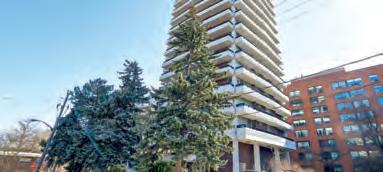











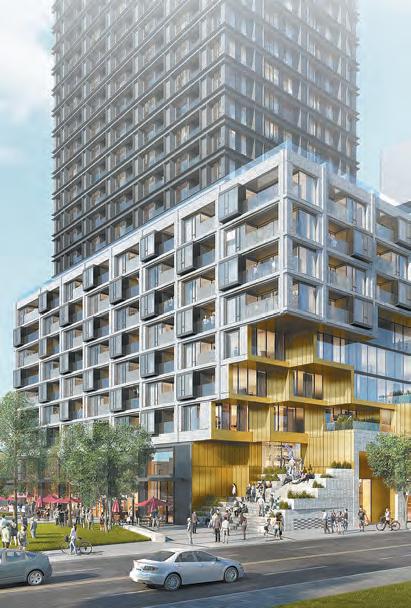

In recent years, Toronto has witnessed a surge in proposals for the redevelopment of its shopping malls, aiming to reshape urban spaces into vibrant mixed-use communities. These ambitious projects promise to blend residential, commercial and recreational elements, revitalizing aging infrastructure and enriching the city's landscape.
With all the talk of a housing crisis and the need to ramp up development, shopping malls and the vast surface parking lots that are associated with them are ideal housing sites. According to a city spokesperson, shopping mall activity could result in“an increase to the City’s housing supply, with approximately 68,000 residential units being proposed across 19 mall sites as of 2023.”
City councillor Gord Perks, chair of the city’s housing and planning committee, said surface parking lots make no sense in a growing city such as Toronto.
“I think Toronto's reaching the point of maturity where there are so many things we can do with land that have higher value than
parking. That the big parking lots are the dinosaurs and the comet is on the way,” he said. Here is a look.
Centerpoint Wonderland
Centerpoint Mall, located at 6464 Yonge St. in North York, is the site of an ambitious proposal by Revenue Properties Company, which has outlined a phased redevelopment plan spanning several years. This extensive undertaking involves the construction of 22 new buildings, comprising a mix of 18 highrises and four mid-rises, ultimately delivering 8,325 new residential units. Central to the vision for Centerpoint Mall is the creation of an interconnected community, including the establishment of a sprawling 20,000square-foot public park, designed to cater to diverse recreational needs, as well as a 9,200-squarefoot retail component fronting on Steeles Avenue.
Sherway Meadows
Cadillac Fairview's ambitious revitalization plans for Sherway Gardens span multiple phases.
This comprehensive redevelopment initiative aims to breathe new life into the surrounding landscape. The initial phase includes the construction of four new towers, offering a total of 6,278 residential units alongside retail and recreational amenities. At the heart of the Sherway Gardens revitalization is the emphasis on community-centric design principles. The proposal prioritizes the creation of public spaces with 14,000 square metres of new non-residential uses, such as public parks and open spaces, as well as public and private roads and a pedestrian plaza.
Bayview by the River
The proposed redevelopment of Bayview Village Shopping Centre epitomizes urban modernization and revitalization, with plans for six towers, including two south towers of 30 and 29 storeys and a north tower of 20 storeys. A feature of the Bayview Village project is its focus on enhancing public amenities and green spaces with pedestrian-friendly design elements. The ground-level retail
area faces a retail promenade, designed as a pedestrian-centric space that re-establishes the contemporary mall's connection to its origins as an open-air mall.
Eglinton LRTville
The proposed regeneration of Eglinton Square includes plans for seven towers ranging from six to 50 storeys. This project aims to redefine the urban landscape, offering a mix of residential, commercial and recreational amenities in addition to adding more than 1,600 units to the housing mix. Spanning an area of 7.7 hectares, the redevelopment presents an opportunity to create vibrant urban hubs that cater to diverse lifestyles and preferences. The Eglinton Square site is just part of a massive redevelopment of the entire Golden Mile along Eglinton Avenue East between Victoria Park Avenue and Birchmount Road that will bring a total of almost 38,000 units.
Fairview by the Sea Cadillac Fairview, in partnership with Shape Properties, has begun
the redevelopment of Fairview Mall with an application to transform the vast surface parking lots into vibrant urban communities. With plans for three highrise towers and more than 1,400 units, this project aims to reimagine the mall's parking areas, enhancing both functionality and esthetics. The proposal includes a village green, outdoor amenity spaces and a retail pavilion.
Yorkdale Mews at the Mall
The redevelopment plans of Oxford Properties for Yorkdale Shopping Centre herald a transformative shift in Toronto's urban landscape. With proposals for 19 highrise towers comprising more than 5,000 residential units, this project aims to create a vibrant new city within the city. Central to the Yorkdale mall redevelopment is the challenge of balancing growth with sustainability and community well-being. The proposal includes plans for public parks, green spaces and pedestrianfriendly infrastructure, fostering a sense of connectivity and inclusivity.
— Ron Johnson







Our
efficient municipal service — issuing parking tickets — is becoming more expensive.
On Aug. 1, parking fines are scheduled to increase by 150 per cent throughout the city and include fines of $75 for not paying at a meter or parking on a street without a valid permit. Parking in a bike lane could cost $200 — more than parking too close to a fire hydrant.
The city administration suggests this policy move is not a money grab, but a way to manage congestion. The new fines are expected to bring in an additional $40 million per year.
If it’s not a money grab, and the city really wanted to manage congestion, there wouldn’t be parking on major arterial roads at all. It is the most inefficient use of road space. Given there is no political will to do that, parking fines are the substitute.
In the hierarchy of parking infractions, one of the worst is parking on a major arterial road when it is not permitted and, in the process, obstructing the flow of traffic for thousands of commuters. In those instances, the fine should be high.
Parking in a bike lane is lower on the hierarchy of parking infractions. Although it is certainly frustrating and should be discouraged, it should not result in
a fine that is equivalent to a week’s worth of groceries. Parking on a residential street without a permit is at the bottom of the list of offences, and a $75 fine is excessive.
Many streets have permits, and parking between midnight and 10 a.m. is not permitted. Usually these are on streets in which the houses don’t have driveways, so permits help protect spots for those who live on the street. Although it is annoying when spots aren’t available for those who do live on the street, it is not clear it equates to a nuisance charge of $75.
For the many streets that don’t have permits, the city bylaw states that there is a three-hour parking maximum. I believe that, on occasion, the police issue parking tickets to an entire street just because they can, not because it has any impact on congestion.
Hopefully the police realize that the impact of issuing these tickets is not worth the revenue.
In neighbourhoods where auto thefts are skyrocketing, the police would be well advised not to spend their time issuing parking tickets. There are better ways to address congestion.


The latest provincial attack on Toronto restricts the city’s ability to protect heritage buildings and places. It is part of Bill 23, giving a much freer hand to the development industry to do what it wants. This restriction comes into force on Jan. 1, 2025.
Ironically, there’s nothing conservative about any of it.
The protection of historic structures and places comes about through the Ontario Heritage Act, passed in 1970. It permits a municipality to designate structures to protect them from demolition, and in 1972 a committee was established at city hall to look at what buildings should be designated. As a first term alderman I was a member of that committee, and we relied on Douglas Richardson, a professor at University of Toronto with a focus on historical buildings, to come up with the first list of what should be designated.
He suggested about 400 buildings that needed protection. Few of them were under immediate threat of demolition, but of course one always had to be vigilant. The process of designation was complicated, time-consuming and expensive, and we realized that city council would never agree to proceed with all 400. I suggested a work-around.
Suppose we simply presented the list to city council for approval, without proceeding to
designation, and then gave the list to the building department? If a permit was applied for to demolish or alter a structure on the list, the building department would immediately notify city council, and the appropriate person could begin negotiations with the developer to save the building. If negotiations were not successful, then council could proceed with designation.
Council adopted that procedure in 1973 and it has been very successful. Negotiations have usually resulted in buildings or their important aspects being retained. Generally the development industry has not been unhappy with the process, which has become known as “listing.”
Most municipalities in Ontario have adopted the listing process and used it for the last 50 years.
Bill 23 requires that by Jan. 1, 2025, every municipality must get rid of the listing process. Toronto is not permitted to have a list of heritage buildings to be protected. The city can use the expensive and time-consuming process to designate buildings, but it cannot use this informal process to ensure that early negotiations with a developer take place.
City staff are trying to figure out what to do. There are now about 4,000 buildings on the city list. Yes, that may include some that have a dubious heritage status, but it is an informal pro-

cess, and the weak ones can get pushed aside during negotiations, but there are clearly many on the list of real value. How could the city ever designate 1,000 or more buildings by the end of the year?
Last year the city designated less than 75 structures, and, if it worked really hard, it could designate 100 this year. That still leaves a lot of valuable history without protection.
Maybe another work-around is possible. Council could forgo listing and instead ask heritage staff to informally let the building department know what structures are important so it can keep an eye on building permits. But one can see Premier Ford weighing in on anything that tries to protect heritage buildings.
It used to be that one could rely on conservative politicians to conserve the past, whether structures or institutions or processes. But this Conservative Party buys none of this and has no problem changing the way judges are appointed or allowing medical operations to be performed by private companies or slashing the ability of conservation authorities to protect the natural environment or putting universities and colleges under financial strain — or protect our built heritage.


CF
CF




It’s not about how much money you make. It’s about how much money you keep.
We understand the tax bill is often the biggest expense in a portfolio, and at the highest level of tax, every dollar saved is equivalent to more than two dollars earned.
 Dustin Mann, B.Comm, CIM® , MFin
Senior Wealth Advisor & Portfolio Manager
Dustin Mann, B.Comm, CIM® , MFin
Senior Wealth Advisor & Portfolio Manager

iA





Someone paying $15 million for a Bridle Path house isn’t that unusual for the city of Toronto’s priciest enclave, but what pricked up the city’s collective ears was the news following the sale that the house would simply be demolished.
The outdoors is nothing to scoff at, boasting two acres of peaceful gardens and a private tennis court located on a twoacre ravine lot.
The news has generated major discussions across social media, with some surprised that such a beautiful, large house is being demolished.
“Such a shame, actually a very nice house with character,” one person commented on the online forum Reddit. “This could easily have been updated. Will probably be replaced with some sort of soulless monstrosity.”







The 19,000-square-foot mansion at Park Lane Circle will be torn down, according to a recent permit that was issued by the city. The Bridle Path mansion was placed on the market in September of 2020 at $18 million. It reportedly sold in February 2021 for $15.48 million. According to the city, the permit was issued in late March to demolish the existing two-and-a-half-storey dwelling and construct a new single-family dwelling, with an associated indoor basketball court, indoor pool and basement walkout.
Another Redditor noted that the “Bridle Path has maybe 20~ houses/lots that are empty or essentially abandoned that are roughly the same size as this lot. I don't think condos will ever be built in this area anytime soon!”

The current mansion that is slated to be demolished has a plush interior, featuring eight bedrooms, 10 bathrooms, three kitchens and a guest suite with a private entrance, as well as a grand ballroom with chandeliers dripping in crystals and a living room with a wet bar. The wood-burning marble fireplaces, hand-painted ceilings, arched entryways and french doors emit elegance.
The Bridle Path neighbourhood in Toronto is one of the city’s priciest slices of real estate. The area near Leslie Street and Lawrence Avenue East counts rapper Drake as a resident. The area was also home to late, great musician Prince, and Elton John has been known to throw a party or two in the area.
— Nisean Lorde
Despite much speculation, the Green P Parking Lot behind Eglinton Avenue near Avenue Road is not going to be developed, according to local city councillor Mike Colle.
“Let me be absolutely clear the city is not negotiating with the applicant on acquiring the Green P Parking Lot,” Colle said. “As I stated categorically at the community meeting, our small businesses on Eglinton see the Green P Lot as essential, plus if this lot was to have any other use, it would be as a public park, like what I did behind the Capitol Theatre at Young and Castlefield.”
Rumours of the development connected to a housing application on Eglinton for a 19-storey development arose at the same time a City of Toronto report is set to look at the housing potential of city-owned surface parking lots across the city.
According to a report by David Jollimore, Toronto's deputy city manager, there are approximately 130 public parking lots scattered throughout the city, with 74 strategically situated within what's termed as "major transit station areas" — zones adjacent to public transit hubs. The report views these parking lots as potential sites for innovative housing solutions, a departure from their current function primarily as spaces for private car storage.
“Surface parking is about the worst land use you can think of,” said city councillor Gord Perks, also chair of the city’s planning and housing committee. “In a city that is short of housing, of green spaces, of community centres, of just about everything you can name, using part of our scarce land for a parking lot is just backwards and terrible.”
The city's strategy involves identifying city-owned parcels
“Surface parking is about the worst land use you can think of.”
along transit routes and stations, where residents are less reliant on personal vehicles. These parcels, often referred to as "lazy land," are viewed as prime candidates for redevelopment. For instance, a site at Dundas West and Ossington Avenue, currently occupied by less than half an acre of parking space, is slated for transformation into a residential community, featuring a 10-storey mass timber building offering 100 units of purpose-built housing.
“There are sites where in some cases you can park for 24 hours for as little as, you know, five to 10 dollars for 24 hours, which makes no sense when they're sit-
ting next to billions of dollars worth of transit infrastructure,” said Mark Richardson, volunteer technical lead for the advocacy group HousingNowTO. “We have a choice in the city about what it is we want to subsidize.”
As the idea of repurposing parking lots for housing gains momentum, challenges persist. Concerns regarding the feasibility of such projects, as well as potential impacts on parking availability and revenue generation, demand careful consideration. Nevertheless, city officials have expressed optimism about the prospects of these initiatives, buoyed by the identification of 130 suitable sites out of the city's portfolio of 300 parking facilities.
How to get them built is another question, but Perks thinks the city’s renewed role as a public builder will help push these projects ahead where private market developers are sitting on the sidelines.
“Private market developers will only come into an agreement if they can extract value, right? So we're giving away some socially owned or publicly owned wealth [land] in exchange for affordable housing,” he said. “And that's silly.”
The report was scheduled to be discussed at a Toronto City Council meeting on March 20.
— Ron Johnson







The city is amidst a spike in approved development applications being revisited with requests for more height and density. Given the push for more housing, it makes sense. And, for most, it is a minor variance and a visit to the Toronto Committee of Adjustment. But one application on Pleasant Boulevard near Yonge Street and St. Clair Avenue seemed to cross an imaginary line when it asked for 15 additional storeys.
The development, located at 29–39 Pleasant Blvd., near St. Clair subway station, is the subject of a new full zoning bylaw amendment application to restart the process in an effort to build a 50-storey tower.
It’s a case that gave city councillor Josh Matlow the realization that the city planning department isn’t sure of the mysterious line that the development crosses to go from a minor variance to having to go back a few steps and resubmit a full application and go through the subsequent meetings and deliberation.
“I literally asked this very question of city staff. And I didn't realize how rhetorical I was because I said, ‘Could somebody in city staff just give me a definition of minor variance?’ They couldn't. So I'm happy to tell you
that councillor [Dianne] Saxe and I have made this request that they work on that.”
Previous proposals on the Pleasant Boulevard site include a seven-storey office building and a 34-storey residential tower. Despite prior approval for a 35storey structure, revisions culminated in a 50-storey plan.
The location's designation as a Major Transit Station Area has facilitated the request for increase in height and density.
“The next opportunity to provide input is at the Toronto and East York Community Council meeting [the statutory meeting] when the application is considered,” said city spokesperson Deborah Blackstone.
The proposal, currently under review, maintains a narrow public park plan along the site's west side and includes a 140-squaremetre privately owned publicly accessible space (POPS).
“The current proposal represents an important opportunity to better optimize the site and create much needed housing with direct access to higherorder transit infrastructure, including the Yonge-University subway line and the St. Clair LRT," said Courtney HeronMonk, a planner for Bousfields Inc., in the development submission. — Ron Johnson

In the urban fabric of Toronto, few neighbourhoods command the prestige and allure of Yorkville. Once hailed as the veritable epicentre of the city's social and cultural life, this historic neighborhood is on the cusp of a monumental resurgence spurred on by the massive changes coming to the corner of Yonge Street and Bloor Street.
Yes, the centre of the city is about to regain its swagger.
Paul Donato, for one, is excited to see it happen. He’s the founder of the Ballroom, a beloved 14-year-old casual bowling and entertainment facility at Richmond Street West and John Street that is opening an exciting new facility at One Bloor East in the former location of a McEwan food store.
The Ballroom will replace McEwan food store, and the former Nordstrom Rack space will be split by its floors. Avant will open on the 30,000-squarefoot upper level of the former Nordstrom store.
The 8,000-square-foot main floor of the former Nordstrom at the southeast corner of Yonge and Bloor streets will become the flagship branch for Scotiabank, and the Nike flagship store will take up approximately 17,000 square feet of space over two levels.
In addition, Spanish retailer Mango is opening its first retail
storefront, and across the street Lululemon is opening a massive flagship store.
The revitalization of the area also includes massive condo development highlighted by The One condo, the tallest in Canada, as well as a new W Hotel at 90 Bloor St. E. beside the old Hudson’s Bay.
"We were first in there, and I'm just incredibly proud of that. With tenants like Nike, Shake Shack and Scotiabank coming
“I really do feel like a kid on Christmas morning.”
in, it's a testament to the neighbourhood's revitalization."
The Yorkville Ballroom is scheduled to open by the end of March, and it will be unlike anything the city has seen .
“You kind of go see it to believe it. I know it sounds like a sales pitch, but you just got to go see it,” said Donato. “I really do feel like a kid on Christmas morning. I think it's just so offthe-charts different from anything out there, just like in the Entertainment District. I think everybody's going to love it.”
News of the Ballroom opening is buoyed by the announcement of the full leasing of retail space at One Bloor East, which
marked a watershed moment in Yorkville's history.
Eric Sherman, the head of national operations at First Capital REIT, recently shared the long-awaited news, signalling the completion of leasing endeavours encompassing more than 80,000 square feet across three levels.
“We are proud of the spectacular roster of tenants we will be welcoming to this iconic corner, which includes a curated mix of F&B [food and beverage service] and entertainment, health and wellness, flagship fashion and a financial institution, all of whom are of the best in their respective categories,” Sherman stated.
The podium features three levels of flagship retail space at the base of a mixed-use 76-storey condominium tower.
Moreover, the $1.5 billion revitalization of the Bloor-Yonge subway station is ongoing and will improve accessibility and connectivity in Yorkville.
With massive renovations underway, the station is poised to emerge as a modern transportation hub, linking Yorkville to Toronto’s downtown.
As these initiatives unfurl, Yorkville stands poised to captivate the collective imagination of Toronto residents and visitors alike.
— Ron Johnson





8 Gardiner Road
Stunning 3-storey home in Forest Hill on 64'x132' lot. This centre hall plan boasts 6 bdrms/6 baths, formal living & dining, conservatory w/ skylight, 2nd floor family rm & fin. bsmt w/ rec room. Private drive & double attached garage.
33 Jackes Avenue #403
Full service boutique building in midtown! Approx. 2923 sq.ft., 2 bdrms+library/2.5 baths and south-east views of the city and ravine. 2 parking & 2 lockers, 24 hr security with valet parking, indoor pool, exercise room, party room. Mins. to shops & TTC.
525 Markham Street
Semi-detached 3-storey home on 24x125 ft lot in prime Annex! 4 bdrms +den/3.5 baths. Spacious living rm, dining rm & eat-in kitchen. Fin. bsmt w/ rec room, bdrm, & laundry room. Detached double garage via laneway. Mins. to shops & TTC.
90B Shaftesbury Avenue
Semi-detached residence on a 15.8 x 74.5 ft lot. 3 storey with 3 bdrms & 3.5 baths. Raised dining room overlooks the living room. Spacious eat-in kitchen. Parking via laneway. Close to Yonge St. shops & Summerhill subway station.
300 Bloor St. E. #1001
The Bellagio! 2 bedroom split plan, 2 full baths, open living & dining area w/gas fireplace, eat-in kitchen w/granite counters, open balcony with north, east and west views! Parking and locker incld. Mins to shopping, dining & subway!








Eataly has staked out nearly 9,800 square feet at CF Shops at Don Mills, and the Italian hot spot will be opening soon! More details about the new location at 1090 Don Mills Rd. haven’t been shared yet, but the brand is planning for a spring 2024 opening.
Isabella’s Mochi Donuts is opening on Bayview this month, giving Leaside residents a chance to taste these unique doughnuts that have been a favourite since husband-and-wife team David and Cecilia Noon first opened the shop in 2016. Flavours include miso brown butter–chocolate chip, tiramisù, Earl Grey crème brulée and more that will be unveiled every week at 1699 Bayview Ave.
Plato’s Closet just opened a new location at 39 Orfus Rd., in North York, moving into an area that has become a destination for second-hand shopping. The





name brand-focused thrift store also encourages customers to visit the store to sell their gently used clothing.
Piggy’s Island has reopened in Thornhill at 5 Glen Cameron Rd. after a devastating fire shut down the place almost three years ago. The family-run spot is back to offering an authentic Korean barbecue experience for patrons, including a 12-ingredient beef marinade, an ox bone soup slow cooked for 72 hours and pork and kimchi stew.
Old School Barber just opened on Eglinton and visitors in the neighbourhood have been loving it so far! With a modern and minimalist interior, customers have been served espressos alongside fresh cuts for the ultimate luxury barbershop experience. The new shop at 558 Eglinton Ave. W. is open every day other than Monday.
Upper Canada Choristers is celebrating its 30th anniversary on May 10 at Grace Church onthe-Hill! The concert will feature four new compositions, including one by a Grade 5 student and a guest boys choir of Maurice Cody School. The performance is happening at 300 Lonsdale Rd.
Nick Vitantonio, a fixture in the Forest Hill community and the third-generation owner of Forest Hill Barbershop at 408 Spadina Rd., recently passed away. Nick considered customers his friends and family and raised almost $2 million for SickKids and Diabetes Canada with the barbershop’s annual golf tournaments. He was known for his jokes at the shop, his own wine tasting during holidays and his dedication to the community — so much so that a lane was named after him in Forest Hill. He will be greatly missed and celebrated in the village.
















Kosher for Passover under COR
Gift Baskets, Trays and Platters

Chocolate Matzahs and Seder Plates

Pareve Chocolates, Bark and Mints Passover
www.chocolatecharm.ca (416) 787-4256


Delivery
3541 Bathurst Street (Across from Baycrest)












































COMPANY SPECIALTY: STONEWORK AND LANDSCAPING REFERENCES AVAILABLE: YES
LENGTH OF WARRANTY: 2 YEAR WARRANTY FREE ESTIMATES: YES
Northern Stone Design Inc., a family run landscaping company, gears itself every season to making landscape dreams a reality for hundreds of GTA customers. The staff at Northern Stone Design Inc. have a combined trade experience of over 50 years, specializing in stone work and softscape for any residential or commercial property. If quality of workmanship and customer satisfaction are your top priorities, look no further than Northern Stone Design Inc. Northern Stone Design Inc. gives at home estimates and consultation for free and looks forward to a great 2024 season with its GTA customers.
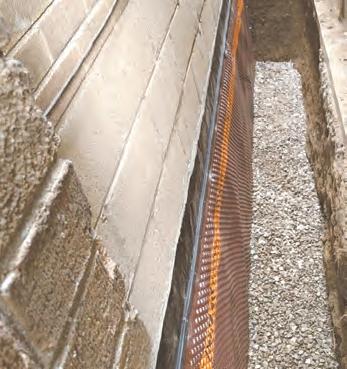
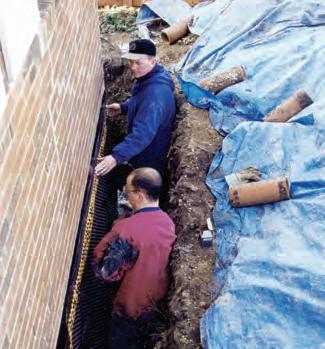
COMPANY SPECIALTY: BASEMENT WATERPROOFING, BASEMENT LOWERING YEARS IN BUSINESS: 38 FREE ESTIMATES: YES REFERENCES AVAILABLE: YES
There are many potential health risks that lurk in a wet basement. The goals of Royal Waterproofing are to stop the water-flow into your home, eliminate mold, mildew and possible allergy triggers and repair and prevent further damage to your home's foundation, resulting in a dry basement. Whether the water seepage is due to deterioration of existing materials, blockage of foundation drains, breakage, clogging or lack of weeping tiles, we tackle the problem where it begins - outside your home. Lifetime guarantee! Since 1985.

























































In partnership with the Rotman School of Management. Special thanks to our incredible sponsor The RE/MAX Collection.
Our 17th annual unscripted & unrehearsed discussion with nine housing experts on the city’s favourite spring topic


THE MODERATORS LIZA FROMER & JULIA MASTROIANNI

THE HGTV STAR SEBASTIAN CLOVIS Co-Host, HGTV Canada; Principal, Clovis Contracting

THE SALES PRO BARRY COHEN President, RE/MAX Realtron Barry Cohen Homes Inc.

THE INFLUENCER ANYA ETTINGER Realtor, Bosley Real Estate Ltd.

THE DESIGNER BRIAN GLUCKSTEIN Principal, Gluckstein Design; Author

THE BROKER MICHAEL KALLES President, Harvey Kalles

THE DEVELOPER JENNIFER KEESMAAT President and CEO, Collecdev-Markee

THE CONDO KING BRAD LAMB President, Brad J. Lamb Realty & Lamb Development Corp.

THE ARCHITECT BRIGITTE SHIM Co-Founder, Shim-Sutcliffe Architects

THE BANKER BENJAMIN TAL Deputy Chief Economist, CIBC World Markets Inc.
POST: As we do each year, we will kick things off with an update on the economy and interest rates from the country's top real estate economist, Benjamin Tal.

BENJAMIN TAL: If the real and ultimate measure of intelligence is what you do when you don't know what to do, then the next few weeks, months and quarters will test the economic IQ of the Bank of Canada because they are the first to admit that they have no clue what's happening. We are all making it up as we go. So I know that by now, many of you are very disappointed because, after all, everybody promised you a recession, and we didn't get a recession. So where is that recession?
Let me tell you. We are in a recession. We are in a per capita recession. Per capita GDP is down by 2.5 per cent, per capita consumption is down by 3 per cent. So the only reason why the economy is above zero is because of the fact that we got 1.2 million people into this country in a very short period of time. This is not a way to grow an economy. India also has a lot of people. What we need is GDP per capita growing, not just getting more and more people into the country without being able to grow the economy. So that's more or less where we are, and we have to improve on that.
At the end of the day, although everybody is talking about inflation, this is not about inflation. This is about the cost of bringing inflation down to 2 per cent,
which is the target. The Bank of Canada, the ECB in Europe, the Fed in the U.S., they have all established their reputation as inflation fighters. They will do whatever it takes to bring it back to 2 per cent. And we can argue until we are blue in the face to what extent 2 per cent is the right number. I don't think it's the right number. I think it's higher. But they are not going to change it.
So the Bank of Canada — and this is extremely important if you care about mortgage rates — the Bank of Canada is a biased bank. You wake them up in the middle of the night and you ask, “Recession or inflation?” They will take a recession any day. So they overshoot by design.
If the Bank of Canada was an AI machine, they would have stopped raising interest rates 50 basis points ago.
You can overshoot in two ways. You can raise interest rates way too high, and you can keep them high for too long, and they are going to do both. Now, we must discuss inflation, but before that, we have to realize that the GDP in Canada is now approaching zero. So we are very close to a technical recession or a very, very, very soft landing. And that's exactly what the Bank of Canada would like to see. I had a lunch meeting with some clients the other day, and they asked me on the way there, "Are you going to give us good news?" And I said, "Depends what they are serving for lunch."
What is good news? If tomorrow I tell you that GDP growth is 5 per cent, the labour market is generating 100,000 new jobs, very strong, is it good news or bad
news? Well, for the Bank of Canada it is a nightmare because they want to see the economy slowing down. Bad news is good news because it means that the Bank of Canada will not be raising more if you have bad news. So bad news is good news. And if bad news is good news, I have plenty of good news for you today.
I believe that all those major inflationary forces that were unfolding are now turning into disinflationary forces. Supply chain is back to normal. This means that prices of goods are starting to go down.
And then there’s interest payments on mortgages. The Bank of Canada is raising interest rates to fight inflation. Higher interest rates are adding to inflation through mortgage interest payments that are rising by 30 per cent a year. It's madness. Nobody will be able to convince me that higher mortgage interest payments are disinflationary.
If you remove mortgage interest payments — and by the way, the Bank of Canada is one of the only banks in the universe that uses mortgage interest payments in the CPI [Canadian Consumer Price Index] — from the calculations, inflation becomes 1.5 per cent — already below target. And that's why the Bank of Canada is overshooting. Still, they announced on March 6 that they're not going to raise interest rates but not giving us hints when they're going to cut. So I'll tell you when they're going to cut: June. June will be the first cut. I think they're ready for that, and they will start hinting in April that they're ready to do so. Now, by how much?
We started this saga at 1.75 per cent overnight rate. We are at 5 per cent now. Staying there until June. It will go down to what? I say 2.75 per cent. Why 2.75 per cent? Because economically speaking, COVID was a condition that accelerated so many forces and trends. We all know the story. One of them is deglobalization that is now actually inflationary, replacing globalization that was disinflationary. We used to have just-in-time inventories that were actually disinflationary, now we have just-in-case inventories, inflationary.
The labour market used to be giving, forgiving. Now it's tight, inflationary, and all those green initiatives, they're inflationary. For inflationary forces, the target is 2 per cent. Clearly by definition, interest rates have to be higher than they were before. And let me remind you that the real estate market in Canada can do extremely well. The real estate market in Toronto can do extremely well at a 3 per cent overnight rate if we know the direction. And if we are in equilibrium: interest rates were too low. Three per cent will be the right number, and things will do fine when interest rates are 3 per cent.
POST: Now, we'll ask Barry Cohen, the country's top carriage trade agent, for an update on the current state of the condo, home and investment property markets.

BARRY COHEN: Well, to understand what's in store for 2024, I think we have to first understand what happened in 2023: 2023 was full of uncertainty, a lot of stops and goes.

BRAD LAMB: Generally speaking, prices have dropped about 10 to 15 per cent from the early spring of 2022. So if Ben is right, and they start reducing rates in June, and we get a 2 per cent decrease in rates over the next year or so, this time next year, we will have recovered all of that, and we'll probably be about 4 per cent or 5 per cent over what the prices were back then.
Going forward, I just don't really see what can change the inevitable. I think Toronto and Canada are a very desirable city and country to live in. We are expensive. We are not the most expensive in the world. We may someday be the most expensive in the world because we are probably one of the best cities and countries in the world to live in. I think there's going to have to be solutions about how to solve those problems. But price-wise and looking in the crystal ball, prices will rise as soon as interest rates start to fall.
BARRY COHEN: I think that it's inevitable prices will continue to rise. It just won't stop. When I was in my 20s, I think, 11 per cent was our normal. And now we're looking at 5 and 6 per cent. And I think it's really about an adjustment. If rates don't come down, I hope Benjamin is right — and I do believe he is — but if they don't come down, there will be an adjustment because you have other forces like the baby boomers, wealth inheritances, money being passed down to the children. That's a force. Immigrants are a force. Interest rates at 6 per cent are so bad, but once you get down to 2.75 per cent, watch out. So I think that Toronto Real Estate Board will probably have about 80,000 in sales. They're predicting 77,000. And I think prices will go up somewhere between 8 and 10 per cent this year.
At the end of the year, the stats were very simple. Condos and freehold pretty much were the same. They each dropped about 5 per cent to 5.5 per cent in value, and activity was down 12 per cent in both categories. Sellers were holding back. So we were inventory challenged, and it's a good part of the reason why we had fewer sales.
And it was a very challenging year because interest rates were climbing until about the summer. And then they leveled off. And it’s interesting: when they leveled off, you saw that the market became vibrant, and the higher-end was moving. And then our new mayor came up with the new land transfer tax, and things just stopped. We're moderately busy in every category, and then, lo and behold, I started noticing that the wealthy around October were buying real estate to avoid the new tax rates, which in some cases was an increase of 1 per cent to 5 per cent. And they're buying, buying as long as they can close by December.
And I thought that that was unexpected because I thought that the rich might stand on the sidelines and say, "Hey, you know, if rates are not going to change or go up, prices are going to fall, and I'll wait until next year.” Or “I'll avoid the tax, and I'll wait until next year and maybe get it for 90 cents on the dollar." But they were buying. And that was great. And then all of a sudden, Benjamin Tal came out — I think it was about the end of November — with his prediction that rates would fall somewhere between 1 per cent and 1.5 per cent. And what happened was, I felt in December — Michael might share that opinion — that it continued to be busy irrespective of the closing date. There was this optimism. And that's the way we started the year of 2024: optimism.
So far, it's go, go, go, so you have this optimism. The Toronto Real Estate Board reported at the end of January sales are up 37 per cent and sales are up in February. That just came up. The two averaged out to be over 18 per cent of the same time last year. I mean, that's very good, but what it doesn't talk to is the different categories. You have to understand that, when the Toronto Real Estate Board reports, 98 per cent of their data is for homes under $2.5 million. If I should sell an $8 million, a $10 million or a $20 million house tonight, it won't change the statistics. When you look more specifically, the low end under $3 million is roar-
ing. The up to $3 to $5 million is moving. Over $5 million is sluggish. When you go over $7.5 million, it's just completely at a stop. That will change. And if Benjamin is right and interest rates will go down, then I think that the balance between lower interest rates and paying the higher land taxes will serve the high-end buyers and sellers well.
if we can't figure out a way to consistently continue building homes. That's actually the bigger risk that we face. Most people in our city and most people particularly coming into this city as newcomers, their first aspiration is actually stable housing. And stable housing can be high-quality rental housing if we are building highquality rental housing that is stable.
POST: Everybody is very concerned about the first-time homebuyer, whether you're the prime minister or a parent. Jennifer and Anya, how have things changed for the first-time buyer in 2024 in Toronto?

JENNIFER KEESMAAT: Well, this is a great question because the foundation of the Canadian dream for so many years was access to home ownership and becoming a first-time homebuyer. And of course, over the course of the past several years, that is something that has fundamentally shifted and access to home ownership has increasingly become out of reach. So if we look in the Toronto context, in 1970, the average price of the average home was about two times the average salary. Today, it's 10 times the average salary. In Vancouver, it's 12 times the average salary.
So accessing home ownership is something that has increasingly been a dream that many people cannot attain, and that is something that has only been accentuated and become more extreme in the context of increasing interest rates. Ironically, I had a colleague who was looking at a condo and wanted to buy a condo. She looked at it a few years ago. It was way out of her price range. About three months ago, it looked like the price had dropped significantly. She thought, "Fantastic, now's my time to get into the market."
And so I said, "Well, just go play around with that mortgage calculator for a minute." And she did. And of course, given interest rates, the carrying costs of the condo were actually higher at a significantly lower purchase price than it was back when interest rates were much lower. So this idea that the average worker in the city of Toronto and that the average household can access home ownership is something that has increasingly been moving beyond reach.
Is there reason to despair? I would say no. I think there's only reason to despair
For a very long time, we used the condo market to offset a lack of new purposebuilt rental. We have some pretty powerful incentives coming forward right now from the federal government, including the forgiveness of GST, on purpose-built rentals. But there's still a lot of other factors that are making it incredibly difficult just to bring any type of housing supply to the market right now. So all of that wonderful immigration — which is not the right way to grow the economy, I heard from Benjamin — also had the unintended impact of really further tightening our housing supply and access to housing for newcomers and for young people, resulting in a whole series of incredibly wonky outcomes in terms of our labour market, for example.
Many young people working in the city of Toronto today have the unenviable situation of an hour or an hour and a half commute because people are moving further and further outside of the urban core.
So the upshot of all of that is that we deceive ourselves if we focus on first-time homebuyers as being the fundamental challenge that we face as a society that wants a growing economy and that needs immigration. We have to be thinking more broadly about access to housing and in particular affordable housing that is in close proximity to transit and other urban amenities that present the opportunity of living without a car, the opportunity of living a little bit smaller in exchange for living in a fantastic urban environment. But if we don't deliver on the urban environment, and if we simply don't deliver on the housing, all of that part of the dream will fall apart and crumble as well.

ANYA ETTINGER: We've really gotten into quite a lose-lose situation in Toronto. Home ownership is a huge goal that a lot of my peers have, but it is so unattainable, it is so out of reach that a lot of people in their 20s, even their early 30s, are wondering if it's ever going to be a possibility. Now, that's a combination of high borrowing costs and it being extremely
difficult to qualify for a mortgage, especially as a single person, but on top of that, being able to save enough for a down payment. So if you don't have help from parents or from family or have come into a large sum of money, it is virtually impossible for the average Canadian, the average Torontonian, to get into the housing market on their own.
Now, the other side of that lose-lose is a lot of people are being forced out of rentals because rental prices are going up. So to afford to buy a starter condo you need to be making at least $100,000 to be able to qualify for a mortgage. But to be able to afford an average-priced one-bedroom rental as a single person, if you follow the 30 per cent rule, you need to be making $80,000. So it's not all that much cheaper to be renting either. So we've really gotten into a tough spot because it's too expensive to rent, it's too expensive to buy, and now a lot of people, especially young people, are being forced to decide:
"Well, where am I going to put my money? Am I going to have to sacrifice certain things and locations to be able to simply have my own place, or am I going to have to live with roommates until I'm 30 or 40?"
That's a big struggle on top of that now we have a new first home savings account with a very low yearly limit. So it's going to take 10 years to have enough to put down 20 per cent if you're exclusively using that account. There are so many barriers for people that want to get into the market as a first-time homebuyer that I'm seeing a lot of people, a lot of prospective clients, and even just consumers I'm speaking to, that are really struggling to find a way, a path. They don't know where to go, they don't know where to look. There's so much misinformation, there's so much distrust between the consumer and the real estate industry as a whole that I'm finding people are just really lost and they don't know where to go. They're
With growing construction costs and land values increasing, it's no secret that condos in Toronto are only getting smaller. See how much the average square footage of condo units in medium and highrise buildings has changed since 1996!
looking to people for guidance, and they're looking to resources, but with all the conflicting information and a very uncertain environment and climate we've seen over the last few years, they're really just not sure what to do.
And I think that we need to change our legislation so that there is more trust between the consumer and the real estate industry so they don't feel as though they're being lied to, or they're being screwed over. But also putting in building more housing, building more livable housing. Condos are getting smaller and smaller. People are needing to make more and more sacrifices to get really just their foot into the door.
So there needs to be a shift in both the buyer's mindset or the renter's mindset, and there are certain things I'm going to need to sacrifice to be able to get my foot into the door. I'm not going to get my dream home on my first try. Maybe I get a studio, maybe I buy a duplex with a friend, maybe I buy a triplex with a couple of friends. You need to look at your alternatives and be willing to sacrifice. Maybe I'm not going to get a parking spot. Maybe I'm going to have to get a Murphy bed. You're not going to get your dream home, and that's OK. As long as you get your foot in the door, that's where you start. So I think that's a really big thing that we need to focus on.

JENNIFER KEESMAAT: I think you're going to see more developers trying to figure out how to get into the purposebuilt rental space, precisely because it's a way to mitigate the short-term risk of not being able to bring condo product to market. I'm very much hoping that we will see more incentives from the federal government to help get purpose-built rental built. I think we're going to see some very, very big announcements in the next four to six weeks from the provincial government around changes to the planning approvals process in order to expedite getting land entitled so that the barrier to getting housing built isn't going to be the approvals process.
POST: For a lot of first-time buyers, that foot in the door can be a condo, as you said, and the condo market is finally seeing some life with a year-over-year increase in sales. So, Brad and Brian, where does the market go from here?

BRAD LAMB: So I have good news. And the good news is today is the best time going forward forever to buy a home. Today is the best time. Tomorrow is worse than today, but today is the best time. And the reason for that is we've gone through a correction in the real estate market that's been based largely on interest rate policy. In fact, I'd say pretty well entirely on that. And as Ben has said, that is likely to change going forward for the better for people. And right now, the way most consumers are feeling, according to our sense of things, is that the fact that rates have stayed stable for five or six months makes people feel comfortable that they can make a decision and not fear
Right now in my inbox, I probably have between five to 10 zoned sites a day that are coming across my desk: people who have a site that's zoned that they're trying to offload because they don't want to build it and they don't want to hold onto it and carry it. Hopefully, that will slow down, but that's a lot of property right now that's sitting on the market that is already zoned.
The federal government also in the next four to six weeks is going to be making some massive announcements mostly with respect to figuring out a way to unlock federally owned land, provincially owned lands through incentives and municipally owned lands. And that could move the needle and shift some of the thinking in the industry around the type of product that people are willing to build. And I think that anyone who has highrise condo products is going to continue to wait. It's way too risky to launch anything right now in light of so many projects having launched over the course of the past 12 months that didn’t sell past 30 per cent, so they couldn’t move forward.

BRIAN GLUCKSTEIN: Real estate is always an incredible investment. And in Toronto, it is never going to go down. I mean, if it blips down, it's going to go way up. We have to ask ourselves what's the lifestyle we want to have. And I look at friends that live in New York and London and Paris, and they live in modest little rentals in the city. And they bought beautiful houses in the country. There’s a pair of doctors that are friends of mine that live in New York. The apartment they raised their son in was so small, and finally they said, “Enough. This apartment is a fortune. What are we doing?”
And they sold the apartment. They rent a small apartment. They work close to the hospitals. And every Friday, they go to the country with their son, and he rides his bike, and he plays basketball, and they have fun. So the real question is, what is the life you want to have?
But when it comes also to affordability and the prices of Toronto, I don't know if I said it last year, but my parents went through the same thing. And they told me that, when they were sitting around a table when they were young and they all had houses, their first houses or their second houses, one couple bought a house. And they all said — the couple wasn't there — they [the absent couple] will never get their money back. They're crazy. Who spends that on a house and it's an old house? The house was $90,000. It just sold for $9 million. But my parents said, “We would laugh, we said they're never going to get their money back.” So whenever we think we’ve reached the peak, we're going to be saying that $2 million Leslieville house is now $5 million and $7 million. We're going to look back and say, we should have bought 10 of them. Like we say to our parents! It’s still the best investment.
the future.
Every day going forward will be a more positive day for real estate, which is the good news. The bad news is it means prices will continue to rise. Right now, you can buy an existing condominium in Toronto in a pretty good building for $1,200 a square foot. To sell it to you brand new, I need $1,600 a foot. That spread of $400 a foot, about $150 to $200 of it is what happened to the market over the last two years. Take advantage of that because it's going away. I can't build anything until the price goes from $1,200 to $1,400 because we need to sell for $1,600, but a consumer will pay $1,400 for something that's delivered in four or five years.
The problem now is that builders aren't building anymore. We put our last building in the ground in the summer, and those units were previously sold in February 2022. We have four towers we're building right now. We haven't sold anything in our new projects for two years and a month, meaning we're two years and a month behind building our next building.
Every single developer in the city is in exactly the same place. Last year, 13,000 new condominiums sold in the city. Typically, in the GTA, we want to see around 25,000 to 30,000 new condos sold. Now, you might think, "Well, that's not so bad. Those 13,000 condos will get built." But they won't get built because all the developers have sold 30 per cent or 40 per cent of their projects and they can't get started. You can't get started unless you've sold 70 per cent of your building, and every developer is in the same situation. There are some very wellheeled developers that will risk $300 million or $400 million of their cash to get started and then worry about financing it later, but there's a handful of those. Pretty well every other developer in the city needs to sell first.
What we do is we sell 70 per cent, which allows us to borrow 75 per cent of the cost of the building. So, what you're going to see is that the last crane went in the ground sometime around September, October. It's different for purpose-built rentals.
So we have a shortage coming up in about three years. We already have a shortage now. We're going to have a worse shortage in about three years because of this interest rate policy. And what do shortages do? They make prices
go higher. The other problem we have in our development industry is that inflation has been about 20 per cent overall in the last three years, which has also inflated the cost of building. It affects everything. So concrete prices are higher. Trades got a 6 per cent increase in one year alone.
Now, our problem is that if we want to bring a building to market, we have that issue with higher prices, but construction prices will fall because no one will be going into the ground in the next two or three years as no one's sold enough to do that. And then trades will start to lay people off because they don't have enough business to keep all the people.
Then what will happen is this year and next year, we'll start selling lots of condos again, and we'll go back to the trades and say, "Now we've got a record year of sales. We need you to build these." They’ll say, "Well, we shrunk the business. We don't have enough people anymore." So it'll be competition for materials and trades, which will cause prices to rise. So the problem with all of this interest rate stuff is it's just going to punish the consumer badly.
So, I think that right now, my number is $1,600 a foot. That's what I need today. In two years, I'm going to need $1,800 a foot. So, I'm like every other developer in the city. We all work on the same numbers. We all buy land for roughly the same price. We all put in the same appliances and use a certain number of architects. Our prices aren't that much different in terms of our cost and selling prices. So what we're in for is, I think, some pain, and I don't really know what can be done to protect the consumer from this. I don't think there's enough money in the treasury. I don't think there's enough money in Canada to solve the problem. All the condos we need to build, at the rate we have to build them, we're just not going to be able to do it. And I'm the bearer of bad news again, but I just think what it means for all of you is higher prices. So if you're looking to buy, today is the best day ever.
BRIAN GLUCKSTEIN: I was listening to the radio this morning and they said we need three million more homes in Canada by 2030. It will probably take us 60 years to build three million new homes. It's not possible.possible.
BENJAMIN TAL: Actually, the number is updated now. It's five million.

BRIAN GLUCKSTEIN: Five million.
So that's a hundred years. And they want it in six years, and as Brad knows, it takes six years to get your project approved. So I don't know where this is coming from, but real estate is always a fantastic investment. We've all bought property over the years. It's always gone up. We've always said, "I can't believe it, it can't go any higher," and it keeps going higher. So it is always a great investment, but affordability is not possible.
If I hear someone say one more time, "Well, we're going to build more because we're going to make it more affordable," it's not possible. The land is too expensive. The cost to build is too expensive. They're building houses so far out of the city that are still $1,400 a foot and $1,500 a foot. It's not that much cheaper to move out of the city, and you can't dumb the buildings down anymore. You can't strip any of the finishes. The finishes aren't that great in the first place. You look at what's being built. All the money goes into a common area, and the suite has nothing in it. So when you're looking at 500 square feet at $800,000 or $900,000, and it's not going to get any cheaper, how is that going to be affordable for someone making $70,000 or $80,000 a year when the city is raising the real estate taxes and the mortgage rates are going up? I don't see how it's ever going to happen. And you can build as much as you want, and someone says, "Well, you'll build a lot and prices will come down." Five million houses you have to build for the prices to come down. It's not going to happen. So, I don't know what the solution is. But when we talk about rentals and everybody mentions condos and rentals, which we'll get into, that is not stable housing.

I have a question for Brad. One thing I've really struggled with with pre-construction is how to justify the … I think you said $400 gap that you need — what you need to sell it for versus what the current resale price is trading at. So how is it that you, with your target demographic or your target buyers, how are you able to justify that and where are you kind of seeing people being able to forgo buying something cheaper today than buying something more expensive that they'll get in six years?
BRAD LAMB: Well, it's unjustifiable. We can't justify it, and that's why they're not
selling. That's why, as I said, 13,000 condos sold last year spread over hundreds of projects, and nobody achieved even close to the numbers to start building. So they're all offering discounts on parking, you know, rent guarantees, Rolls Royces in buildings to drive you around to your appointments. It's not justifiable.
What is justifiable — and we've seen this for the last eight or nine years — it used to be a smaller gap when prices were lower. What is justifiable is about a $200 gap. Over five years, you can expect prices to rise 5 per cent to 6 per cent, and that means that, by the time you close on your brand new condo, it's worth what you paid for it or a little bit more. But more importantly, what's great about buying a new condo is that, if you don't have the ability to put up $100,000 right away, what we do in the development industry is give you time to put your deposits down, right? So if you buy a condominium for $700,000 and you need a $100,000 deposit, we'll give you two or
three years to put the money down in 15 or so tranches so you can get there. So it's kind of a forced savings program that gets you into the business or into home ownership in five years as opposed to instantaneously in today's market. But you can't justify $400 a foot [gap], and that's why there's no new cranes going up.
per cent of the entire market. So I've got some bad news and then I've got some temporary good news.
POST: The market for detached homes has been moving in fits and starts with many potential buyers waiting on the sidelines for interest rates to drop. Michael and Sebastian, when will demand return and what will that mean for the market?

MICHAEL KALLES: To bring context to it, a single-family detached home in the core of Toronto right now averages at $2.5 million. And further context, there were 147 sales all of last month, which makes up 2.6
Here in Toronto, the desire for single-family living in a detached house comes with a hefty price tag. But how do we match up to some of the biggest cities in the world? These are the average prices for a detached home, based on most recent data and converted to Canadian dollars.
The bad news is, if you think pricing in Toronto is high now, watch out. In the next two to three years, pricing is going to be through the roof on single-family detached homes. So one thing to think about when we're talking about the timing of an interest rate drop: if it happens in June — so right now we're in March — if you think about it for a moment, the first drop, they're not going to drop it by 150 basis points. They'll probably drop it by a quarter point. That's going to force people to flood the market. The confidence is going to come back, the exuberance is going to come back, and that's going to drive pricing up.
And when I talk about the 147 sales, the reason why there's so few is because there's no product, there's no availability, there's no selection. So I think it's important to keep that in mind. The most important point is the opportunity. Brad said it very well: the opportunity is right now. People are thinking to themselves, "OK, well, I'll wait till June, and we'll get a quarter point reduction in the overnight rates and that will equate to a slightly lower mortgage rate." But if you think about what's going to happen to demand and price appreciation, it's better to buy today, if you could afford it, than waiting because, by the time you wait, the slight decrease in your mortgage rate is not going to make up for the incredibly improved pricing of those same homes.

SEBASTIAN CLOVIS: I don't know if there's a lot of demand for detached homes right now, but I do know that there's a lot of desire. There's a lot of people in this city who really do want to live in an area that has more space and a proper home to raise their family in. From what I read today, you know, in Toronto, which is an extremely densely populated city, for every square kilometre, there's 4,000 occupants. That's like 1,000 metres squared, 4,000 occupants. That is a staggering number to me. I live right in the downtown core. So I feel it every single day when I walk my dog. And I would imagine that, like myself, many people in Toronto do have a strong desire for detached homes. It just doesn't correlate with the cost of living and the cost of those homes.
And so we have an opportunity to change desire into demand if we are creating the right kind of homes in the right
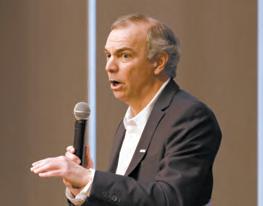
BENJAMIN TAL: I think that the spring will be decent. I think the fall will be strong. I think that with interest rates going down, the market will wake up. I think the pioneer of the recovery will be low-rise. I think highrise will have to wait to clear the inventories, and I totally agree that two years from now, highrise will be on fire because we simply won't have supply. So that's the way I see the situation unfolding.
BRIGITTE SHIM: So, my family moved from Kingston, Jamaica, to Toronto in 1965. And we've seen this kind of amazing transformation of the city through immigrants. And they have actually built the city that we have. All kinds of ethnic groups across the board and many of their children are some of the biggest developers in the city. How we address the trades, how we train the workers that will build this housing need. It's kind of a key crisis.
We've been talking about interest rates and a whole lot of things, but the people that will build our city are not the kind of immigrants that came before. They need to know how to work with their hands, but they also need to be able to run sophisticated equipment like a five-axis computerized manufacturing machine really well. And they need both those skills at the same time. So we really need apprenticeship programs to train the workers of the next generation that will build our housing. We can't even consider a prefab unless we have these specialized skills that can actually do this work. And that really needs to be where the effort for provincial, federal, local governments are, because it's so critical to construction, and construction is so critical to housing.

SEBASTIAN CLOVIS: I think that the housing situation is going to get a little bit worse. I think we may see people pulling their income properties off the market. I think this cash-for-keys situation that we're seeing in the city is very scary for mom-and-pop investors. It's going to be harder for these small landlords to maintain. I think that's a real issue. I think that the housing starts and home building starts and completions are going to slow down over the next couple of years.
Building costs are just way too high. Materials are too high. Supply chain is too high. We just don't have the builders. So we can want to build all we want, but if we don't have those things in place, then we really can't get it done. I think that with that slowdown comes an opportunity though. And it may be a small one, but we have to see a silver lining in it. And if we're slowing down on the building, then perhaps that can give us an opportunity to think about the type of communities that we want to be building so that — as we're building these communities, these houses — [we’re] making sure that they have access to transit and all the amenities that they need and making sure that we're building the right kind of places that people want to live in and are sustainable.
If we can figure those things out — well, it’s like we're trying to build a plane while it's flying or build a bridge while it's on fire; everyone's heart is beating — but if we could take a breath and really city plan forward, it will make sure that these next steps that we do take are the best ones.
kind of places. It was a common thought years ago that you would become a homebuyer or a homeowner. If you lived in Toronto and you rented in Toronto at a reasonable rate, you could save up money and then you probably wouldn't be able to buy inside Toronto because it's very expensive. So you move to the outskirts somewhere, Vaughan, Markham, East Gwillimbury, any of these kinds of places, and get a cheaper house with a little bit of space, a backyard for your dog and your kids. But the prices of the homes that we're building out in those neighbourhoods are staggering as well. There's no significant decrease in the price if you move outside of the city as to whether you stay inside the city. It makes more sense to stay inside the city because this is where all of the amenities are. So we have a high demand for living spaces or high desire for living spaces, but we have a low demand on the actual properties that are there because they're just not affordable. I don't think that that means that we should give up on the dream of being homeowners or detached homeowners. I just think that maybe it means that we need to change up the dream a little bit. As a designer and a builder, that means that it's time to ideate and think about how we go about reimagining the cities that we're living in and perhaps building in a different way. Maybe we need to be thinking about how we're building outside of the city of Toronto and make those spaces more comfortable so that people can go out there and don't need to commute into the city so much.
We are building houses, but those houses outside the city, they're still very expensive. So who are we building those houses for if people can't afford them? Are we just building them for these investment people that put their money together and buy these houses? Are we just buying them for companies so that they can purchase these homes and then rent them back to people forever? I don't think that's how I want to live. I don't think it's how a lot of people want to live. And so I think there's a reimagining that's necessary.

JENNIFER KEESMAAT: A key part of where we build is a focus on recognizing that, over the course of the past 10 years, 75 per cent of all new homes have been built in new communities, in greenfields, in places where we don't have water, we don't have
roads, we don't have schools, we don't have transit. So we have to build out all of that infrastructure, which, believe it or not, makes building the home very, very expensive. There's no road, there's no water, there's no electricity. We need to dream a better dream, and it's a little bit different from what you've articulated, which is we need to get better at infill development and building up where we already have infrastructure, and here's where you and I diverge. We don't diverge often, Sebastian, but here's where we diverge. Toronto is not a dense city. The vast majority of Toronto has been losing density in 80 per cent of the land area. Families are becoming smaller in our suburban areas, homes are becoming bigger, that's losing density. It's why we have many schools in the city right now that are not even at 50 per cent capacity in the city.
So a really big part of where we build and building better and building in a sustainable way is building in areas where we already have infrastructure. And it does mean a different dream in terms of thinking about housing in a fundamentally different way, thinking about housing options, thinking about fourplexes, thinking about six-storey buildings, thinking about a diversity of housing types, which you find in most great cities of the world.
Our challenge right now — that you experience when you're walking your dog, Sebastian — is that we've gone into part of the dream. We're building density, but we haven't been investing in the infrastructure that makes dense urban living really high quality and really wonderful. Those kinds of urban places that you like to visit on vacation, like Paris and London and Barcelona, all those places that Torontonians and Canadians go to and say, "Oh, it's so wonderful." And then we come back home and we're like, “Man, density sucks.” We don't have that density here. We are not as dense as Paris. We're not as dense even remotely as Barcelona or London, which by the way, are mid-rise cities. Our problem is very much our public infrastructure investments. And I will just say having a kid who grew up in a single-family home at Yonge and Eglinton, my kid has no illusion about owning a single-family home. And she's a young professional. She just wants to live in a great neighbourhood where she can walk everywhere, where she can get on transit to see her friends, where she can raise a family and not have to worry about getting kicked out because the rent went up. But I think the illusion for millennials
isn't about home ownership. It's actually about wanting to be able to figure out a way to stay in the city. And the way to do it is to think about housing in a very different way.

BRIGITTE SHIM: I've been an advocate of laneway housing for the last 25 years. I live in a house in a back alley. It used to be a bunch of derelict cars, but we had to go up against the Ontario Municipal Board at the time to build a 1,350-square-foot house. And it was a real David and Goliath story. But in 2018, with a lot of work from a lot of people, laneway housing is now as-of-right condition. You can go for a building permit if you meet certain requirements. And what I've seen over the last few years is a really interesting phenomena because all of the development that everyone else is talking about is really top down, requiring banks and developers and assembling large parcels of land.
What's so interesting for me about laneway housing is that they're actually average people who want choices. They want a place for an elder parent or a workspace in their backyard as a studio or for a teenage kid to live or any number of scenarios that allows you to have flexibility in your single-family house over time. And I feel like what we need as citizens is choice. And we have very few choices. You can buy the two-and-ahalf-million-dollar house in a singlefamily residential neighbourhood or a condo that Brad will sell you really easily, but there's very little in between. Over your time period on this earth, your needs change. You need spaces for your kids, your parents get older, and you have so many changing needs over time. So laneway housing, garden suites are not the answer when they're presented as affordable. They're not quite affordable. But what I'm seeing, which is so interesting, is that it is a bottom-up movement. It actually is regular people having a level of empowerment over a degree of flexibility that's happening through all residential neighbourhoods in the city. And for someone like Jane Jacobs, what you want to do is live in a village within a metropolis. You want to support all the infrastructure that Jennifer's talking about: the schools, the transit, the
services, and you want to support those services and strengthen them as opposed to eating up, you know, greenfield lands on the outskirts and having to drive an hour and a half. I teach at the University of Toronto, and I polled my students, and 80 per cent of them spend an hour and a half on transit. They have to live in a suburban area because they can't afford to be in the downtown. They have to get on two or three modes of transit to get to class. So I guess I'm an advocate for choice. And for the choice being of the average citizen having a little bit of control to be able to at least make a difference in their lives and create equity at the same time. And I feel like we're at the beginning of that. So all things like laneway housing, garden suites are in their infancy stage, but the fact that they even exist I think is a very positive step forward. I think, like Jennifer was saying, we have to redefine what density is. And we
are nowhere near dense. When we think about Toronto relative to global cities, we are so not dense and so low-rise, except in these designated transit nodes where you can build a 90-storey tower at the foot of Yonge and the Lakeshore. So there you're allowed to be super high. And then there are residential neighbourhoods where there's no change that's happened for decades. So we have to redefine and recalibrate where density goes and part of it is wanting to make great cities as opposed to just adding houses. So the issues of the quality of public spaces, parks and schools and cultural facilities are about making a better city and housing as an integral part of that vision.
POST: Brian and Sebastian, how does the question of density translate to home renovations?
With material and labour costs on the rise, it was a tough year for home renovations. See how home improvement costs played out in Ontario and Canada in 2023.
$30,994
Average cost of a full kitchen renovation in Canada, or $195 per square foot
34%
Amount of Canadians who have postponed renovations due to rising interest rates
$14,378
Average amount of money Ontario homeowners spent on renovations in 2023
25%
Amount of Canadian homeowners who expect their kids to move home due to finances
*Sources:

BRIAN GLUCKSTEIN: We're seeing many more buyers or potential buyers getting out of the market and saying, we will change the house we live in. They were, at one point, looking to move up or even move down. And now they're saying, the gap is so big. Even if you're downsizing, the gap is big for many people. So it's more expensive to leave your house and buy a condo.
So we're seeing a lot more people that are saying, “We are going to change the house.” And then you're looking at people that are making multi-family homes within their family. So they're moving their parents into the house, or they're moving their children into the house. And they may be moving into the garden suite and giving the house to their children. So we're seeing some interesting changes happening to the way people are looking at the existing house they have and saying, “We're not looking at what's happening in the market.” And if they have the two families living in there, that helps subsidize the renovations.

$13,393
Average cost of a full bathroom renovation in Canada
25%
Amount of Canadians who expect to live in a multigenerational household in 10 years
34%
Amount of Ontario homeowners who completed at least one emergency repair in 2023
$11,884
Average amount of money Ontario homeowners expect to spend on renovations in 2024
SEBASTIAN CLOVIS: I think that's a definite trend that we're seeing. When I started on this panel five years ago, I think the first thing I said, probably to my chagrin, because everyone stared at me, was about flipping. I wasn’t in agreement with flipping houses and just buying up the stock and then flipping it for a return on investment and not caring about who's coming in after. I think that is a part of why we're in the situation that we're in right now. Of course, not the whole thing. That trend died off when the housing stock got so expensive.
And then the renovation scene really kind of changed to people building income properties. And that became a big thing for a couple of years. That's become more of a gamble now because we have a renter class that's so upset with being overcharged that we're seeing issues with income properties. From what I'm seeing, we've had an ability to build laneway houses, garage suites, put fourplexes on residential lots for years now. And we're not seeing a huge uptake in that because it's a major risk. First of all, it's a major investment. Second of all, who wants to risk renting one of those places out when the market is as it is and renters are upset and know that they can withhold their rent?
The tribunal to handle the discourse

ANYA ETTINGER: We talked about detached homes but we didn't really talk about your average starter home, your Leslieville semi, your 25-foot house in midtown. Those are already seeing a massive surge in demand. There are houses that are getting 20 to 30 offers. We're seeing some of the same trends that we saw in late 2021, early 2022 — people are disregarding recent sales and they are doing anything and everything that they can to get the house. The speculation of rates dropping and whether that will be in June, before or after, is already there. People want to beat the rush. So unless there is a massive shift in what's going on over the next few months — a huge dump of supply for instance — I can't imagine that momentum will slow down.
MICHAEL KALLES: My predictions are a little bit longer than short-term. They're medium- and long-term predictions, and I'm incredibly bullish on the market. I think, if we look into the crystal ball, we all see what the story is. The rates are going to come down. All these people have been sitting on the sidelines. These buyers are going to rush back into the market. There's very little supply on the resale and, as Brad said, on the new home sales side. It's going to drive the prices up, and the prices are going to go up exorbitantly, and people are going to be telling the same story that we told two and three years ago. There's nothing available to buy. And I believe, and Brad may disagree, that all of this supply, all of the condo supply that we're talking about now that's sitting stagnant, that's all going to be eaten up within the next probably year to year and a half, maybe two years.









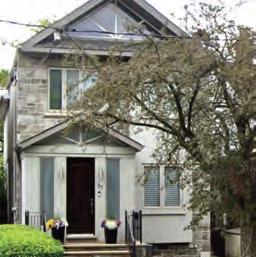







































between renters and the homeowners takes nine months, a year, a year and a half even. If that's a situation where you're renting out an income suite in the bottom of your house and someone is not paying the rent, we're going to see people losing their homes over these things. We're talking about small investors, not big-time property developers. But definitely what we are seeing is the move to multi-generational housing. So now, we're still trying to build converting garages, third stories, under pending building basement suites to protect our extended family from a situation of where the cost of living is so difficult.
And lastly, what I'll just quickly say about the renovation industry as a whole is that we have 700,000 builders retiring in the next five to 10 years. A huge swath of our builders are retiring. And we don't have enough people replacing them coming in. And so where we need innovation within the renovation industry is with getting new people into the trades. We need to embrace different types of programs to get people trained up in remote areas so that we can do the type of building that we need. If we are bringing in so many immigrants, maybe 100,000 of those should be carpenters. And that might help us out a little bit with some of our problems.
BARRY COHEN: It's true, that's one of the biggest problems we have. I don't know who's more important here, your plumber or your doctor. Because people are begging to get trades, and the costs have become so over the top. We see these prices come across our desks every day, and every year we're in shock at how much it costs to renovate. But you can't get the trades. That's the problem.
BENJAMIN TAL: Back to the idea of the missing middle — a few months ago, I had an opportunity to present to the cabinet [of the provincial government] on housing affordability. And my first sentence was, "Listen, if we don't deal with it urgently, we are going to have pockets of civil unrest. We are going to have antiimmigrant sentiment. We are going to
have rental strikes." It's written. I can see the trajectory. We have to wake up. So we have two options, this is a crisis: do nothing, and, looking at the faces of especially young people here, this is not an option. We cannot give up. It's not going to be easy, but we can do things. This is a crisis that requires attention immediately. And I believe we can do that in many, many ways.
The missing middle clearly is a factor. We have to provide different ways of looking at the thing. I totally agree with what other people mentioned here. Now, factory-made houses — I think that's something that we have to think about because other people in other countries are doing it. We cannot build the way we built 50 years ago. So, we have many ways of doing it. We cannot simply give up. We have to continue providing solutions to young people here, and the rental solution will be a big part of it. Purpose-built rentals will be a big part of the solution, and I believe that more incentives to developers to build purpose-built is the right thing to do. I think we can do it. It will not be perfect. Toronto will not be affordable anytime soon, but it can be easier, because at this point, we are basically running faster to stay in the same place.

BRAD LAMB: I have a very quick solution, too, to be able to deliver practical, affordable, highrise housing. I told you all that the cost of delivering a building in Toronto is $1,200 [per foot] plus taxes. So, if we can get that number from $1,200 to $800, then we can build lots of highrise housing. Eight hundred dollars a foot is the number because we get about $400 or $450 a foot for rent. And so, not to bamboozle you with math, but basically, real estate investors want a 5 per cent cap rate [meaning it would take around 20 years to recover what they invested in the property]. You take the rent, divide by the price of the property, and that's what someone will pay for it.
So how do we get down to that number? So in my world, 25 to 30 per cent of my costs are government taxes. So we're doing a building in Mississauga.
It's a $320 million building. Every year the taxes go up with the cities, so over a quarter of that, $88 million, $90 million — imagine that — is going to taxes, HST and levies. In Mississauga, a studio pays close to $70,000. For the privilege of building a studio in a place where there's already lots of electricity and transit and sewer and water, you have to pay as a consumer, because you pay us and we pay the city, $70,000. Then on top of that is community benefit charges, there's parks levies.
We need to get rid of all of those taxes because, at the end of the day, through your rent, you're paying property taxes. The developer or the owner of the building is going to collect the taxes and pay them to the city. So what we need to do is have this stuff go away for 10 years. I think this is the single biggest issue for voting right now. I think people are very concerned about affordable housing and really nothing is being done. The federal government is talking about it, but nothing's happening, I promise you, nothing's going to change, nothing's happening unless serious things happen like this.

JENNIFER KEESMAAT: I think this would be surprising to most people, but in the city of Toronto, when you buy a new home, there's a development charge that has been charged by the city that was charged to the developer that gets passed on to the purchaser for a whole variety of things. So for example, we have subsidized daycare spaces in the city of Toronto. When you buy a new home, you get charged a little bit of money that goes into the pot for subsidized daycare spaces. You get charged a little bit of money for libraries and the TTC.
So it's like we're putting a little surcharge on new homeowners coming into the city. It's a surcharge that is increasing the cost of that housing. And it raises an interesting question: should newcomers be the ones bearing a little bit of extra cost, which, when you add it all together, becomes a lot of extra cost, between 23 and 26 per cent of the cost of building a new home are government charges. So, if you think about something that can be
done very quickly to moderate the high cost of building new housing, that's something that's completely within the government's control, right? The government can, through the stroke of a pen, say, "You know what? We're going to stop putting the burden of infrastructure on new people coming into the housing market. Instead, we're going to create an infrastructure fund," right?
POST: Around 45 per cent of Canadian mortgage-holders are renewing their mortgages in 2024 and 2025. What advice would you give them?

BENJAMIN TAL: Given where we are in the cycle right now, it’s reasonable to suggest that rates will be lower two years from now.
ANYA ETTINGER: I’m seeing a lot more borrowers opting for variable rate mortgages with the hopes that rates will come down enough in the next year or two to cover the spread between fixed and variable. I’d say, if you are a more conservative borrower and relatively risk averse, a three-year fixed is likely your best bet. If you are comfortable with the risk and can stomach a higher mortgage payment for at least 12 months, variable would be a good option.
BRAD LAMB: Since it is likely rates will fall during 2024 and 2025, just renew for one year until rates drop approximately 2 per cent to a Bank of Canada rate of 3 per cent.
BRIAN GLUCKSTEIN: I would opt for a mortgage that you can prepay at any time without penalty. If interest rates go down, you can either negotiate with the bank or go to another bank to get a competitive interest rate for a new mortgage and pay off the old mortgage. I would probably go variable — because I don’t think the interest rates are going to go up that much — they will probably only go down, so you want to take advantage of that. Why lock in at the highest we’ve seen in a number of years?
There are many people in our city who don’t have basic shelter and a roof over their heads; with that in mind, Post City, Streets of Toronto and the Rotman School have made donations on behalf of our panellists, our readers and our sponsor, The RE/MAX Collection, to Sistering, an organization supporting unhoused women and trans people in Toronto, and to Red Door Shelter, which provides sanctuary for families.

Dr. David Black graduated from the University of Waterloo, School of Optometry in 2004. For almost 19 years, Dr. Black has been providing eye care to his North York community. He is passionate about providing outstanding patient centered care and is constantly looking for new ways to improve the quality of life of his patients.

Eyestrain and headaches have long been an issue for many people and have worsened by our increasing use of screens. Having an up to date glasses prescription can help but often that alone doesn't resolve the problem. And what about people who don't have a prescription? We now have a new option that can potentially reduce or eliminate eyestrain altogether, it’s called Neurolens.
It is well documented that eye alignment or "teaming" issues can cause a bevy of symptoms including eyestrain, tired eyes, headaches, neck pain, nausea, light sensitivity, and dry eye-like symptoms. Even small misalignments can cause painful symptoms. Previously it was very difficult to accurately measure these misalignments and they can vary depending on your viewing distance. This made it difficult to prescribe prism (an optical component of glasses that helps eye alignment) in patients’ glasses because the amount of prism would remain constant throughout the lens.
With the advent of new eye alignment
Wills made today actually speak from the date of your death. With our explosive markets, assets and debts you had yesterday may not be the same today or the next or even next year. That will apply also when you die. Your assets and debts may be more or less, and some assets and debts may not even exist at all.
It is common for people when creating a Will to want to tailor it to the assets you have now. For example, you have a house worth $1,500,000.00; $1,000,000.00 in investments which may be bouncing up, down or sideways; household furnishings; and a car. You provide a lawyer with instructions that you want to leave $10,000.00 to each grandchild (there are 10), $25,000.00 to 5 charities and $100,000.00 to one of your children. You then leave the remainder (or residue of your estate as it is called) to your spouse or children or both.
Well that’s fine for today. Maybe you have enough money if you die tomorrow for the Estate Trustee to pay your debts, your funeral expenses, income tax, cash legacies and
measuring technology and the optical industry’s first contoured prism lenses, Neurolens, we can not only measure with precision these eye misalignments but we have a lens that can correct for them! The amount of prism in the glasses is tailored specifically to your eye measurements. And with the contoured prism design, more prism is provided where it is needed most, when viewing objects at close distances like computers, phones and tablets.
A local patient commented on his recent experience with these glasses, "The glasses are actually amazing. I can tell the difference. I didn't even realize before that I would bring my head/neck closer to the screen or page I was reading and now my neck is more relaxed. My eyes are definitely less sensitive to light than before... and no more migraines/major headaches since!!!"
To discover if you are a candidate contact your Optometrist.

Tel: 416-733-4444
www.eyesonsheppard.com
residue. But as life goes on and you sell your house, you spend significant money on health care costs or just on your own personal enjoyment, your assets may dwindle. Or you may be lucky enough to see them even increase.
Some people guided by the provisions in their Will don’t live their lives fully afraid to spend their money because of it. Others could care less and spend it all. You forget to update your Will which is now clearly outdated. You die. There may not be enough left to pay for all those cash legacies, your funeral expenses, debts and income tax and certainly nothing is left for your spouse or children.
So, you should review your Will at least every 5 years. Pull out your list of assets and debts with current values. Look at the economic climate and ask yourself: Does everything that I said in my existing Will make sense now. If not, do a new one. This applies no matter how old you are.
Dr. David Black
Cheryl
accredited mediator and arbitrator with nearly 40 years of family law experience and a Masters Degree in Counselling, helps families navigate separation and divorce. Through mediation and Rapid Resolution, she provides solutions that minimize cost, acrimony, and emotional pain. Cheryl’s unique perspective enables her to resolve seemingly irresolvable differences.

Facing a divorce can be overwhelming. What if you could resolve all disputes in just one day?
That’s where Rapid Resolution - the One Day Solution comes in. This innovative dispute resolution process offers a unique one-day solution to resolve family law disputes, allowing all parties to move forward.
Why Rapid Resolution?
• Time-Efficient: Settle all family law issues (including support, property division and parenting rights) in just one day, unlike traditional divorce proceedings that can take years, draining both time and resources.
• Cost-Effective: This streamlined process significantly reduces costs, compared to lengthy legal battles.
• Voluntary and Safe: Parties voluntarily engage in this process, ensuring a commitment to a safe and fair resolution.
• Full Disclosure: Full and frank financial disclosure is required, ensuring all parties are well informed about financial issues.
• Customized Approach: Each case is unique,
Goldhart Mediation & Arbitration Inc.
601 - 1920 Yonge St., Toronto, ON, M4S 3E6
and Rapid Resolution can be tailored to meet the specific needs of the parties and their particular issues.
How Does It Work?
• Preparation: Parties submit briefs outlining their positions before the scheduled day.
• Mediation/Arbitration: The process begins with mediation, followed by arbitration (if necessary) for unresolved issues, all within the same day.
• Decision and Award: If arbitration is necessary, a decision is made by the end of the day, with a concise award and reasons provided, ensuring closure and clarity.
Ready for peace and closure? Contact Cheryl today to discover how Rapid Resolution can swiftly settle all your family law issues.

416-967-6111
www.goldhartmediation.ca
Living with chronic neck, back, or joint pain is a reality for many, with traditional treatments offering only temporary relief. In search of alternatives, Platelet Enriched Plasma (PRP) therapy emerges as a promising solution, transforming pain management.
PRP injections utilize the body's innate healing mechanisms to target pain at its source. By concentrating platelets from a small blood sample, rich in growth factors for tissue repair, PRP is injected precisely into affected areas, kickstarting the body's healing process.
Precision is a hallmark of PRP therapy, with many facilities offering fluoroscopy-guided injections. This ensures accurate delivery, enhancing effectiveness and reducing risks, providing patients with reliable relief.
Beyond precision, PRP therapy addresses the root cause of pain, promoting long-term relief and improved function. Minimally invasive and often performed on an outpatient basis, PRP allows for a swift return to daily life, appealing to those with busy schedules or limited
recovery time.
Safety is paramount in PRP therapy, as it utilizes the patient's own blood components, minimizing risks of rejection or allergic reactions. This instills confidence in patients as they pursue pain relief.
Most compellingly, PRP therapy has shown significant efficacy in reducing pain levels and enhancing overall quality of life. From athletes aiming to return to peak performance to everyday individuals seeking relief from persistent discomfort, PRP offers a beacon of hope.
Platelet Enriched Plasma (PRP) therapy represents a paradigm shift in pain management, offering a safe, sustainable solution for those grappling with chronic pain.
 Cheryl Goldhart – Expert Family Law Lawyer, Mediator and Arbitrator
Goldhart, an
Cheryl Goldhart – Expert Family Law Lawyer, Mediator and Arbitrator
Goldhart, an

Haley Frydrych
• Do you wear dentures? Many people over the age of 65 use some form of removable denture. While the majority of dentures fit well, some always move, lift and cause discomfort. This may lead to difficulty chewing and lack of confidence in social interactions. There is a strong link between overall good health and proper oral care.
in good health are excellent candidates.
BIO CONTACT
Dr. Lewandowski is a graduate of New York University (NYU) College of Dentistry. He has worked as an instructor at the NYU Faculty of Dentistry, University of Toronto Faculty of Dentistry as well as in a hospital based dental clinic. Dr. Mostyn obtained her dental degree from The Faculty of Dentistry at James Cook University, Australia. Dr. Haley Frydrych received her dental degree from U of T.

With the tumultuous real estate market across the country, spouses contemplating a separation may struggle with handling upswings and downswings in home values. Determining how to handle these scenarios and their impact on finances can cause significant stress for parties going through a separation. When parties separate, factors that can impact the handling of fluctuating home prices include which spouse is on title to a home and whether or not the parties have a domestic cotract
by Kenneth Fishmanthat deals with how a home is divided in the event of separation.
In cases where both spouses’ names are title to a home (whether the parties are married or not), there is a general presumption that the increase in value will be shared between the parties. In practical terms, this benefit crystallizes when the home is sold on the open market or when one spouse buys out the other spouse’s interest at fair market value. If they are married and only one spouse is on title
• Dental implants can help. Implants can restore comfort and confidence, helping people love their dentures again. A dental implant has two parts: a metal root that is secured to the jaw bone and an abutment which securely anchors your denture in place, preventing movement. Versatile implants can replace a single tooth or a bridge, eliminate the need for a removable partial denture or even secure complete full-mouth dentures. Implants have a proven track record for long-term success. When using implants to replace a single tooth, neighbouring teeth do not need to be used as anchors, making it a conservative choice in many cases. Dental implants do not require any special care. Age is not a factor in the success of dental implants. Most people
Dr. Edwin Lewandowski and Associates
1200 Centre St., Suite 101 Thornhill, ON
to the property, the spouse who is not on title will typically share in the value of the home as of the date of separation through the equalization process, which is the statutory formula for the division of matrimonial property in Ontario.
If there is an increase in the value of the home post-separation, the spouse who is not on title is not automatically entitled to share in the increase in the home’s value post-separation. However, this does not mean that they have no recourse for claiming part of this increased value. Depending on the circumstances, a non-titled spouse can advance claims, including trust claims concerning a home, to benefit from the value of a home and any post-separation increase in value. The trust claim will often be utilized by unmarried spouses who are not on title and cannot benefit from equalization, especially if that spouse contributed to the home in some manner (e.g. by making mortgage payments or providing money or labour for maintenance and repairs).
Although trust claims are often beneficial for married spouses who are not on title to a home but wish to benefit from post-separation increases in value, those claims may currently be of limited benefit given the downward trend in home prices over the last year. Most people will not want to share in the decrease in a home’s value. Moreover, as it relates to married spouses, to the extent that there is an increase in value post-separation to share in and a trust claim is advanced by an untitled spouse, doing so will be an uphill battle, as the ex-
• Do you have broken or missing teeth? One Visit Porcelain Crowns may be right for you. A full or partial crown is used to replace or strengthen a broken tooth. When a tooth is filled multiple times throughout a patient's life, the critical tooth structure may be lost. Many of these teeth break and require restoring. Options usually include very large fillings or crowns. Fillings fit inside the tooth and require original tooth structure to hold it all together. If part or all of the original tooth has been lost, then a full coverage crown may be a better option. With digital technology, we can make a direct 3D image of the broken tooth from the patient, design the new tooth (crown) on the computer chairside and have the new tooth made in the office. These crowns are beautiful, strong and functional and permanent. Often done in one visit. Amazing technology!

905-762-0122
www.thornhilldental.com
press purpose of the equalization regime under the Family Law Act is to address unjust enrichment that would otherwise arise when marriages break down. Rather than advance a trust claim, a married spouse could ask for an unequal division of family property under S. 5(6) of the Family Law Act, essentially resulting in that spouse getting a greater share of the family property under appropriate circumstances.
Division of property, including homes, can often be challenging to navigate and contentious for separating spouses or common-law partners. Legal and equitable remedies meant to level the playing field are often complicated and nuanced. If you are separating, it is vital to seek proper legal advice and know your rights so that you can exit the relationship in a fair and financially secure way.
Kenneth Fishman, Partner
Kenneth Fishman has exclusively practiced family law since 2009 and advises clients on all related issues, including parenting, property, and separation. He has been recognized multiple times by Best Lawyers.
Boulby Weinberg LLP
661 Yonge St. Suite 500
647-494-0113
boulbyweinberg.com
Dr. Edwin Lewandowski, Dr. Elvira (Ella) Mostyn, Dr. For separating couples, the division of property, including homes, can be challenging and contentious. POST CITY X UROSPOTSpring is here and it’s time to get outdoors. However, if you are one of the many people who struggle with bladder leaks, it can make thoughts of outdoor enjoyment (away from a bathroom) frustrating. Did you know two out of three women, and countless men find themselves dealing with bladder leaks? This problem is so common but remains a taboo topic people shy away from discussing and suffer with in silence.

• If you pee a little when you laugh, cough, sneeze, lift heavy things, and make sudden movements you are not alone.
• If you are always thinking about where the nearest washroom is, you are not alone.
• If you wake up in the night to pee and wish you could stay asleep, you are not alone.
• If you find yourself wearing protection in case an accident happens, you are not alone.
This is a health problem that needs to be addressed. Once you start leaking it only gets worse with age, and sadly for women, this is the number one reason we are admitted to nursing homes later in life. Healing yourself now helps maintain your independence.
The great news is there is finally a simple fix to this problem. For many, the leaks are caused by a weakening of an important set of muscles called the pelvic floor. This

weakness happens to both men and women as a result of age, pregnancy, childbirth, menopause, prostate issues, hysterectomy, etc. When the pelvic floor muscles become weak, they aren’t able to do their job to keep urine from leaking. If you really strengthen the pelvic floor muscles these issues can go away. The exercise to strengthen the pelvic floor is called a kegel. It is a strong contraction of these muscles at the base of our core. The problem is research shows the majority of us don’t do these exercises properly or long enough to make an impact. Thankfully technology is available to do the work for us so we can quickly regain strength and solve this health problem.
UROSPOT is a Canada’s largest private pelvic health provider that uses Health Canada approved technology to strengthen your pelvic floor for you. The best part is your clothes never come off and no one is touching you.

Life often moves at a fast pace in our bustling city of Toronto. With its busy streets and crowded highways, accidents can happen when you least expect them. Whether it’s a crash on the 401 or a slip and fall on an icy sidewalk, personal injuries can have serious consequences. In the case of a serious injury, you may face additional expenses for medical treatment, assistive devices, home care, or even home modifications. On top of this, you may be unable to work and earn a living.
Suddenly and unexpectedly, the prospect of losing your home looms large. In situations like this, a personal injury lawyer can be your greatest ally in navigating your path forward and securing your future.
One of the primary ways a personal injury lawyer can protect you and your family is by helping you identify and access various forms of compensation. If your injury was caused by someone else's negligence, you may be entitled to
By sitting comfortably on the “Kegel Throne”, electromagnetic energy moves through the chair, through your clothes, focused on your pelvic floor. The energy takes over the muscles and does 11,000 kegels in just 28 minutes. There is no pain and no downtime after. You can feel the muscle contracting, but instead of doing all the hard work yourself, you relax while the technology takes your pelvic floor to new heights. Giving you back the strength you once had. After 6 sessions you will see significant quality of life improvements including sleeping through the night, reduced leaks, reduced pad usage, and less trips to the bathroom. You can be present in the moment instead of thinking about where the next washroom is.
If you want to change your life, regain your freedom, and enjoy being outdoors worry free, then check out UROSPOT. Consultations are complimentary and take only 45 minutes. UROSPOT treats all ages with clients ranging from 24-95. What are you waiting for? The outdoors awaits.
BOOK A COMPLIMENTARY CONSULTATION TODAY.
3080 YONGE STREET, SUITE 5033, TORONTO ON • (416) 874-6268
UROSPOT.COM/UPTOWN-TORONTO
damages through a civil lawsuit. This could include compensation for pain and suffering, past and future medical expenses, home modifications, lost wages, loss of competitive advantage in your career, and other expenses. The compensation paid in a civil lawsuit is intended to make you “whole” (to the extent that money can) and cover any losses that arise from the injuries caused by someone else’s negligence. A good personal injury lawyer will assess the circumstances of your case, develop a litigation strategy that is specific to you, and fight tirelessly to help you secure the compensation you deserve.
In addition to bringing a civil lawsuit, personal injury lawyers can assist you in accessing other benefits that will ease the financial strain caused by a personal injury incident. In the case of a motor vehicle accident, for instance, they can assist you in accessing benefits through automobile insurance policies (called accident benefits and sometimes “no fault” benefits). The types of benefits available to a person involved in a motor vehicle accident include benefits that provide funding for support around the home, treatment, assistive devices, home modifications, and income replacement. If you have an experienced personal injury lawyer in your corner, you can rest assured that the proper benefits will be applied for and, if the insurance company denies them, fought for.
In addition to automobile insurance benefits, a personal injury lawyer can help you access
short-term and long-term disability benefits if your injury prevents you from working. These benefits can provide crucial financial support while you recover, helping you avoid falling behind on mortgage payments or other essential bills.
Unfortunately, these benefits are often denied by insurance companies. Navigating the complex world of insurance can be overwhelming, but with a knowledgeable lawyer by your side, you can increase your chances of a successful outcome.
In Toronto, where the cost of living is high and housing prices continue to soar, the prospect of losing your home due to a personal injury is daunting. However, by enlisting the help of an experienced personal injury lawyer, you can protect your family and secure your future.


Recognizing the unique challenges faced by people living with Diabetes, and rapidly evolving research, The Village Pharmacy is introducing a one-on-one Diabetes Coaching Clinic, right here in Midtown.
“It’s about much more than dropping a few pounds. Small medication and lifestyle tweaks can have a big impact, and allow people living with Diabetes to avoid complications, feel empowered, and take control of their health,’ says Zahid Somani, owner of The Village Pharmacy. “But misinformation about Diabetes is rampant in today’s social media world, especially since the introduction of novel treatments like Ozempic and Mounjaro,” he adds. “It’s become overwhelming for many of our clients.”


sure we’re available to all our clients on the phone, by email, text, and in-person,’” says Monica.
Ethical practice: Honest communication is vital. The Village Pharmacy’s approach to MedsChecks is rooted in genuine concern for their clients’ health, and conforms to professional standards of practice. “While some of the big pharmacy chains focus on quotas and targets, we prioritize integrity, and quality over quantity in every aspect of our community pharmacy practice,” says Zahid.
How the program works: Led by Pharmacists who are also Certified Diabetes Educators, the Diabetes coaching clinic at The Village Pharmacy is a 3-month program that helps people deal with the complexities of Diabetes. Clients work one-on-one with the Pharmacist, starting with a Diabetes MedsCheck and baseline HbA1C testing. The program helps clients resolve medication side effects, optimize blood sugar monitoring, and get guidance on exercise, navigating social triggers, and food choices. The program is free with an Ontario Health Card.
“Many people on Ozempic, for example, don’t realize that side-effects like muscle loss and digestion issues can be mitigated by exercise and nutrition planning,” says
Zahid. “By being proactive, this program helps people achieve lower HbA1C levels and have more energy, no matter which medications they are taking,” he emphasizes.
The program also gives space for goal-setting and regular check-ins. “We're not just here to provide information; we listen to our clients’ questions and concerns, offer encouragement and support, help clients track their progress, and fine-tune strategies that work with their lifestyle," says Monica Nguyen, Pharmacy Manager and Certified Diabetes Educator at the Yonge-Castlefield location. "Our clients know they can count on us to be there for them every step of the way," she adds.
Access is important: Being accessible to their clients is central to how The Village Pharmacy operates. “For many of our clients, picking up the phone is easier. So, we make

Shortages resolved: Ozempic was in short supply last year, though it is now widely available. Health Canada has issued an update confirming an ample supply of Ozempic, so people can feel confident they'll be able to fill their Ozempic prescriptions regularly.
Take the First Step Toward a Healthier Future: The Diabetes Coaching Clinic is free with an Ontario Health Card. You can visit our website, call Monica at 416-4879128, or visit in person. The Village Pharmacy is located at 2518 Yonge Street, north of Castlefield.

2518 YONGE STREET, TORONTO www.thevillagepharmacy.ca



We’re less than a month away from the start of the Stanley Cup playoffs, and things are looking pretty great for the Toronto Maple Leafs’ chances. This year, we have three players to root for who were born and bred blue and white. There’s Markham’s Mitch Marner, the team’s all-star right winger. Defenceman Mark Giordano grew up in North York, and though he’s recovering from a concussion,
he’ll hopefully be back on the ice in time for the April 22 start of the playoffs. And we can’t forget our captain, Mississauga’s John Tavares. With a solid season under their belts, experts are saying it’s very likely the Leafs will clinch a topthree spot in the Atlantic Division, ushering them into the playoffs. When they get there, it’ll definitely be a battle — but hey, we’re used to that! Go Leafs go!


27 carefully considered residences, coming soon to Summerhill.
Starting from $4M.
Full-floor luxury residences available.
Presentation Gallery
1080 Yonge Street
By appointment only
416 800 7738
oneroxboroughwest.com


1. Go to Hyprov
Don’t miss a hilarious night of Hyprov: Improv Under Hypnosis, at CAA Theatre, running April 9 to 21. Direct from Las Vegas, this unique show features Toronto comedy legend Colin Mochrie along with Asad Mecci, who combine hypnosis and improv for an unforgettable comedy experience. Volunteers from the audience are hypnotized, then they join Mochrie onstage to create spontaneous scenes, resulting in an entirely original and hilarious performance every night. With showtimes throughout the week, including matinees on select days, there’s ample opportunity to catch this mind-bending comedy sensation.
2. See Noah Kahan
It is a rare occasion when a humble singer-songwriter sells out the biggest area in town. Doing it three times in one stop is legendary. And that’s what Noah Kahan just did. Kahan brings his signature sound to Scotiabank Arena on April 6, 14 and 16 for his We'll All Be Here Forever Tour. Known for his break-
through single, “Hurt Somebody,” Kahan’s music resonates with audiences worldwide. And $1 from each ticket sold will be donated to The Busyhead Project, supporting mental health treatment and access to care.
3. See All Is Love
Opera Atelier presents All Is Love at Koerner Hall, April 11–14. Immerse yourself in a world of enchantment as Opera Atelier conjures a mesmerizing production, featuring music by renowned composers such as Marc-Antoine Charpentier, Claude Debussy, George Fredric Handel, Henry Purcell, Jean-Phillipe Rameau and more. Led by a stellar cast, including tenor Colin Ainsworth, soprano Measha Brueggergosman-Lee and baritone Jesse Blumberg, accompanied by artists from Atelier Ballet and members of Tafelmusik under the baton of David Fallis. With Marshall Pynkoski as stage director and Jeannette Lajeunesse Zingg as choreographer, this fully staged performance promises an evening of pure magic.
4. Go to Waxahatchee
Acclaimed singer-songwriter Waxahatchee hits the Massey Hall stage on April 23. Katie Crutchfield, known as Waxahatchee, shares her musical journey rooted in Alabama's Waxahatchee Creek. With six acclaimed albums, Crutchfield’s evolution from lo-fi folk to alt-tinged country showcases her honest, poetic voice. Join her for an intimate evening of storytelling through song, where her southern lilting vocals resonate.
5. See A
The always-creative Outside the March theatre company is teaming up with Soulpepper to present Lucas Hnath’s A Public Reading of an Unproduced Screenplay About the Death of Walt Disney. And no, it isn’t really a reading, it’s a play. Directed by Mitchell Cushman and starring the incomparable Diego Matamoros, the play, which runs April 13 to May 5, at the Yonge Centre for the Performing Arts, offers a captivating
exploration of Disney’s legacy. Described as a “blackly comic inversion of the public Disney persona” by the New York Times, the production challenges conventional notions of immortality and wealth. With an intimate audience of fewer than one hundred people, the innovative staging and award-winning design promise a thought-provoking experience that pushes the boundaries of theatrical innovation.
6. Go to El Terremoto
Tarragon Theatre is unveiling the world premiere of El Terremoto, penned by Dora Award–winning playwright Christine Quintana, running from April 2 to 21. Set against the backdrop of a seismic event, this comedic drama delves into the lives of the Jurado sisters, offering a poignant exploration of immigrant identity and the complex interplay between success, determination and suppressed desires and vibrant characters. The production is directed by Guillermo Verdecchia.





Toronto's top meteorologists (and Storm the weather dog!) take Jeanne Beker's favourite spring rain gear for a spin.

Anthony Farnell & Storm
Chief meteorologist, Global News
COAT, Holt Renfrew, $3,290, 50 Bloor St. W., "This is a coat that will last you forever. It's absolutely elegant, and nobody makes trench coats better than the Brits!"
BOOTS, Annie Aime, $158, 42 Ossington Ave., "These are cool. It's not a thick sole, but these are super waterproof. They definitely make a fashion statement!"
UMBRELLA, Good Neighbour, $75, 935 Queen St. E., "That's a very nice plaid that goes great with a classic trench coat, and I like that wooden handle."
STORM’S COAT, Dogfather & Co., $42, 1007 Yonge St.
Natasha Ramsahai
Chief meteorologist, CityNews
COAT, Freda's, $450, 45 Elm St., "This is so vibrant and joyful and has an oversized feel to it — I love the sleeves you can really roll up, the gigantic lapels and the fun button detailing."
BOOTS, Getoutside, $104.99, 437 Queen St. W., "These Chelsea boots are really sharp-looking and great to wear rain or shine. And there's a lot of edge to the lines of this boot."
UMBRELLA, Juxtapose, $56, 430 Bloor St. W., "This is a really pretty floral print that really speaks of spring and optimism and femininity — what a happy umbrella!"
Kelsey McEwen
Chief meteorologist, CTV’s Your Morning
COAT, Hilary MacMillan, $295, hilarymacmillan.com, "This is a really unusual and uplifting colouration, and this is a great plaid for spring. What a fun take on a trench."
BOOTS, Corso Shoes, $99.95, 446 Danforth Ave., "This looks like a great boot to wear all through the summer, and it's nice to have a rain boot with so much colour." UMBRELLA, Good Neighbour, $60, 935 Queen St. E., "This bright yellow colour is so stunning, and I love the little wooden duck at the handle!"
Bill Coulter Meteorologist, CP24
COAT, RW&CO, $143.96, 1 Bass Pro Mills Dr., "This is a great colour and a great length to this coat. It looks very comfortable to get around in and has plenty of classic detailing."
BOOTS, Gravitypope, $168, 1010 Queen St. W., "This is a great boot that will last you forever. This would look good for any kind of pants, jeans or even a dressier look."
UMBRELLA, Grapefruit, $28, 528 Church St., "I love any black and white fashion story, and this umbrella has an almost '60s campy feel. The graphic look is very cool."




As someone who has enjoyed a long media career, including 44 years hosting CBC The Nature of Things, I understand how important robust media is to a thriving democracy. An informed public makes better decisions about everything from health care to voting.
Internet growth has profoundly affected news and information media, for better and worse. In a world of online media outlets and streaming services, as well as social media platforms, the traditional model of selling ad space around articles is no longer viable. Advertising still supports TV and radio broadcasting. But companies must come up with creative ways to survive in a capitalist system and engage readers, viewers and listeners.
Many newspaper and broadcasting companies have been bought up by hedge fund companies and other corporate entities that strip the assets, take the money and close outlets. Community newspapers — incredibly important to areas not covered by big-city media — have been especially hard hit.
Recently, Bell Media decided to sell many of its radio stations, lay off thousands of workers and end much of its news programming. Although parent company
BCE had net earnings of $3 billion last year, executives claimed the move was economically necessary.
British Columbia Premier David Eby argued that monopolistic media companies’ “encrapification” of local news is partly responsible for audience loss.
With so much information now available online, it’s often difficult to separate fact from fiction, truth from disinformation. But traditional outlets that adhere to journalistic standards and provide credible coverage on a wide range of topics still exist.
The growth in new media outlets, often with a focus on critical environmental issues, also gives hope. In Canada, sources such as The Tyee, National Observer, The Narwhal, Rabble, Aboriginal Peoples Television Network and others offer a wide range of investigative reporting, news stories and opinion. There are also many good online community news outlets.
We can all do our part to help journalism thrive by supporting public broadcasting and donating or subscribing to the many new, credible outlets and dependable traditional outlets.

Dear Sangita: I've been dropping hints for the past year for my boyfriend to propose, but he's just not getting it. Is he missing my cues or does he actually just not want to marry me? I'm worried I'm wasting my time. How do I confront him?
—Ringing for a ring
Dear Ringing: You have to ask yourself, why are you in this relationship? Are you in this relationship because you want to get married? Or are you in it because you’re in love with this guy?
You absolutely can have a conversation with your boyfriend about your future together — you really should before getting engaged! I was with my husband for six years before we got married. I invested in that relationship because I knew there was something special and that we were going to spend our lives together. When it was just the right time to get married, we

both kind of weighed and decided it was the time.
If you feel like you could be wasting your time, there might be something else going on — that feeling is not a good sign of a healthy relationship. Fixating on getting married and the wedding won’t be good for your relationship in the long run. Have that conversation with your boyfriend, and it may give you both some peace of mind.
Dear Sangita: I babysat my friends’ two kids once and now they keep expecting me to help out as if I’m their own personal babysitter. We’re very close, so they basically always know when I’m busy or not. How do I say something without hurting their feelings?
—Reluctant babysitter
Dear Reluctant: Because you’re friends, I think you need to be open about how you’re feeling and
University Urology Associates is the premier clinic in Canada for the treatment of enlarged prostate conditions BPH (Benign Prostatic Hyperplasia)
Dr. Elterman offers the latest advanced BPH treatment options including commercially available therapies such as Rezum, UroLift, iTind, Optilume BPH, and Aquablation as well as a new, FREE ultra-minimally invasive and investigational BPH Treatment Option.
Millions of men struggle with urinary symptoms caused by an enlarged prostate, or BPH (benign prostatic hyperplasia). Nearly half of men in their 50’s and over 70% of men in their 60’s have BPH.
As the prostate enlarges, it can cause a range of symptoms such as:
- Frequent need to urinate both day and night
- Weak or interrupted urinary stream
- A sense that you cannot completely empty your bladder
- Urgent feeling of needing to urinate
If you’re living with BPH and are interested in exploring a NEW FREE, non-surgical and INVESTIGATIONAL treatment option, email our office today to see if you qualify:
urologyresearchcanada@gmail.com
say, “Hey, listen, I can do it once in a while, but not all the time.” It’s a hard conversation. I can see why your friends keep asking you — it’s clear they trust you, and it’s hard to find someone you trust with your kids.
It might be helpful to set a time limit for future babysitting asks; that’s something you can set with your friends. You can ask that they’re home at a certain time so that if you have plans you’ll still be able to get to them. You can also say no. I know it’s difficult to do, but you’re allowed to say, “I just need to chill today, even if I’m just at home.” If your friend truly is a friend, she’ll respect that.
Dear Sangita: I’m in a serious relationship, and I find myself wanting to spend a lot of time with this person. The issue is that I have always been of the “don’t bring your partner to the girls’ night” mindset. How do I strike the balance between having my partner around
and not becoming that person?
—Attached at the hip
Dear Attached: I think that you have to ask your friends before you bring your partner with you. And be reasonable — don’t bring them to every single night out. That bond with friends is really important. I truly believe a healthy relationship involves having independence — it’s important to be able to spend a few hours away from your partner without wanting to have them there all the time. You mention that you’ve been annoyed with friends who bring their partners everywhere in the past, so don’t do the same thing to your friends!
Have a relationship or life question for Sangita? Send it to advice@postcity.com.






Devote your time to what is important to you and delegate the day-to-day management of your investments to a professional you trust.
CURRENTS GROWING UP T.O.

NAME: Jennifer Spence
HIGH SCHOOL: North Toronto Collegiate
FAVE T.O. MEMORY: Playing in the streets of her Yonge and Eglinton neighbourhood
FAVE (FORMER)
RESTAURANT: Country Style Hungarian Restaurant
FAVE LOCAL ACTOR: Sandra Oh
Jennifer Spence is starring in Crave series ‘The Trades’
Before Jennifer Spence became a regular on multiple popular sci-fi series and now the lead of a new comedy series from the team behind Trailer Park Boys, she was just a kid testing the waters in a community theatre play in Toronto.
“We did The Crucible, and I met a bunch of other great young women as well — it was a nice group of people to have my first experience with,” she says. “I remember thinking, ‘OK, this is what I want to do. I want to be an actor. I don’t care if it means I’ll be broke; I just love it.’”
After that, Spence went full speed ahead on her acting career, despite plenty of moments of discouragement, she says. “There’s a lot of feast or famine. It can get easy to second-guess yourself,” she says. “But my husband put it nicely — actors are compelled to act. We have this pathological need to tell stories and be a part of something.”
the show led her to a lead role on Canadian sci-fi series Continuum, a recurring role alongside Eric McCormack on Netflix sci-fi series Travelers and eventually a starring role on British crime drama Traces.
So how does the darling of the science fiction genre make the pivot to comedy with The Trades, a new series from the team behind the award-winning Trailer Park Boys?
Spence says the cast made the switch easy for her. “It just felt right. I was blown away by the calibre of talent I was working with. They were all personally funny, not just funny on set!”
The Trades, which premiered on Crave at the end of March, follows a blue-collar community working on a refinery when Spence’s character, Chelsea, steps in as the new site manager from head office. Spence says the comedy is her kind of humour — raunchy and edgy.

Spence started out landing bit parts on movies and TV shows alongside stars such as Jennifer Garner, but soon her career took on an interesting shape — sci-fi star. Her first ever multi-episode arc was on the American science fiction show The 4400, and soon after, she landed her breakout role: Dr. Lisa Park on SGU Stargate Universe. One of a few series in the Stargate military science fiction universe, her popularity on
“I just loved the script from the beginning. I said, ‘Thank God for material that makes me laugh out loud,’” she says. “It felt very authentic; it was a world that I wanted to know more about.”
This being the first “corporate” role Spence has played, she says she translated her own excited and nervous energy into her character’s as the new boss on the block. “It was a fun challenge to play.” — Julia Mastroianni

The wedding
We got married in Saskatoon! Joe has a rather large family, and mine is small, so it made sense to do it there. We did an outdoor ceremony and dinner and dance at the Faculty Club at the University of Saskatchewan. It was the last time every single member of Joe’s family was all together (brothers, sisters, husbands, wives, nephews, nieces). My family was there too along with a few friends. Our honeymoon was a month in England, Scotland, Ireland! We drove around mostly in the countryside — it was magical.
The secret to success
Louise Pitre has a career so long and illustrious that it’s difficult to pick just one standout role — but perhaps her most iconic moment is that of originating the role of Donna Sheridan in Mamma Mia!, which also happened to be her Broadway debut. Dubbed Canada’s first lady of musical theatre, the vocal powerhouse has been in everything from Les Misérables to Company, and now she’s bringing her talents back to Toronto for the Tony Award–winning play The Inheritance, running until April 14. But she has one love even bigger than theatre — her husband of 25 years, fellow theatre actor and playwright, Joe Matheson. Here, she shares the story of their onstage meet-cute and the secret to relationship success.
How they met
We met doing a workshop of a new musical at the long since closed Limelight Dinner Theatre. We rehearsed for three weeks and put on a few presentations for potential investors. The show never got done. It was called Capone. I played Capone’s main “moll,” and my now husband played Bugs Malone. We had a couple of scenes together, and I remember the director telling us that sparks were flying — we had not gone out yet at that point!
The first date
Our first date was at his place to watch a movie while we were still rehearsing Capone. I don’t remember the movie, but I know I stayed much much longer than I had planned.
The relationship
We not only fell in love, but became really, really good friends. One of the most memorable things during that time was seeing how Joe was with his father when he came to visit from Sas-
“We had a few scenes together, and the director told us sparks were flying!”
katoon. Joe told me all about the difficult time he and his dad had had some years back and how they overcame it. To see how they had not only repaired, but deepened their relationship was one of the most beautiful things to see.
The proposal
The proposal was more of a mutual realization! We had been talking, and I said: “I’d marry you.” He then got on his knees and asked the question. I said yes.



I would say that what has worked for us as a couple for these last 25 years is simply this: we talk about everything. It makes us stay up later at night having more drinks than we should, but we never seem to run out of things to talk about. We just don’t want the night to end. And in this business we have found a way to support each other. That is key. We take turns taking care of the other. If one of us gets a job, the other one tries to do the stuff that needs to be done: walking the dog, grocery shopping, cooking, cleaning. When I landed the role of Donna in Mamma Mia! in New York, Joe put his life on hold to come with me and our dog and take care of everything while I worked my butt off. I will never forget that. I could not have done it without him.
Balancing careers and a relationship
I think Joe and I are pretty clear about what truly matters. We always quote from City Slickers: “You are my one thing.” In other words, no job is more important than our marriage. No contest.
The future together
I know Joe would agree with me on our perfect future: a few trips here and there, jobs that we really want to do, continuing to write and compose — we wrote a children’s musical during the pandemic with our friend Diane Leah. The cherry on top would be to see this musical getting done and sitting in an audience to see it and say: ‘’We wrote that!”
One of world class 'Doulton Estates' most iconic homes! Architectural raised bungalow masterpiece blending warm contemporary & stately elegance. Frank Lloyd Wright inspired home overlooking the Credit River with soaring ceilings, elevator, multiple balconies, walk-out basement to manicured approx 1.6 acre grounds, pool, jacuzzi & sunken bar. Expansive luxury estate living at its very best in a truly inspirational & tranquil setting.







































Catch the Toronto Blue Jays home opener against the Seattle Mariners on April 8! Can't make it to the game? No worries! Plenty of spots in the city offer unique flavours to keep you cheering for the home team. At the Korean hot dog spot Chungchun, one of the standout offerings is the gamsung, also known as the potato dog: coated in potato with a drizzle of spicy mayo and BBQ sauce, what’s
not to love? Drawing inspiration from Coney Island, the yummy options at Fancy Franks include the Fancy Texi-Mexi, featuring house-made chili and sour cream and the Fancy La La, with bacon, melted cheese and jalapeno crisps. And skip the long flight to Japan! Grandma Loves You's Japan dog has all the fun with avocado, cucumber, seaweed and wasabi mayo – no passport required.




Inspired by the beauty of spring and thoughts of Paris, we’re on the hunt for Toronto’s best salad niçoise. Join us as French-born chef Nadège Nourian and Michelin-recognized Anthony Rose unveil the standout salad.
NN: “This is the type of tuna (ahi) I like in my niçoise. The two types of potatoes are wonderful.”
AR: “Very pretty! The egg is really nicely cooked, and this salad packs a lot of flavour — it’s seasoned really well.”
432 Wellington St. W., $33


NN: “The capers are really nice! The dressing is a little bit sweet, and I don’t really like the greens, but this is a really well-made salad.”
AR: “I love the anchovies!”
152 Spadina Ave., $17.99

NN: “The dressing is too acidic for my taste, but the green bean is crunchy, I wish that there was more than one; it would add more flavour to the plate.”
AR: “The frisée doesn't seem very fresh, but I enjoy the richness of the salad with the aïoli.”
892 Queen St. W., $18

NN: “Visually, it’s not my favourite, but the ingredients are fresh, and it’s delicious.”
AR: “It’s good, and the tuna is quite nice here.”
80 Blue Jays Way, $16.50
NN: “This doesn’t look very French — more like a caesar salad. Overall, it’s got all of the things you want to see in this type of salad.”
AR: “This is a very tasty salad. Flavour-wise it’s very good.”
506 Lawrence Ave W., North York, $17.99
NN: “This is a very nice French cafeteria type of salad and something I would make at home.”
AR: “This is a textbook niçoise salad. The ingredients are very fresh.”
532 Eglinton Ave. W., $20

NN: “The presentation is top notch and the ingredients are excellent. You would never see branzino in a niçoise, but it really works here!”
AR: “Everything is good here from the ingredients to the seasoning.”
581 Mount Pleasant Rd., $40




Jeremy Diamond is a lawyer and member of both Ontario and Florida Bars. Jeremy practices in the area of Plaintiff personal injury litigation. JEREMY
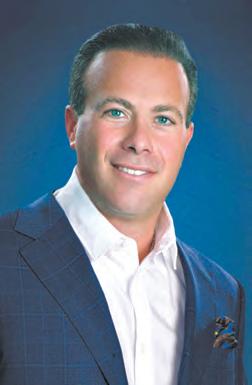
While the rate of motor vehicle accidents on Canada’s roads has declined in recent years due to pandemic safety measures, traffic volumes are increasing once again and collisions continue to cause an alarming amount of injuries every year. Given how commonplace such accidents are for drivers across Canada, many people are investing in dash cameras as a simple piece of tech that can protect your interests in case of a collision. These devices can serve as a crucial witness in the aftermath of a motor vehicle accident, offering valuable insights and evidence that can be a game-changer for any potential legal action.
As Canada’s largest personal injury law firm, Diamond and Diamond has expertise in all aspects of personal injury law. Jeremy Diamond, Partner at Diamond and Diamond, provides a brief overview of dash
cams and why they’re relevant to personal injury law:
1. What Are Dash Cameras?
Dash cameras are small video recording devices mounted on a vehicle’s dashboard that capture real-time footage of your driving experiences. These devices start at around $50 at your local electronics store (costs vary depending on features) and can provide critical evidence in case of an accident, which can have a significant impact on your liability as a party to the collision. “Dash cameras have evolved into essential tools for drivers,” says Jeremy Diamond. “They can be a real game-changer in establishing fault and protecting you from liability should an accident occur.”
Absolutely! Dash cameras can
serve as irrefutable proof of your innocence in the aftermath of a motor vehicle accident by showcasing the negligence of other drivers. The evidence from dash cam footage can thus shield you from unwarranted liability and legal charges while equipping your personal injury lawyers with invaluable evidence for negotiating claim settlements and legal proceedings. As Jeremy Diamond emphasizes, “Dash cameras can be your voice of truth after a collision, capturing details that could make a significant difference in your legal case.”
While insurance companies generally don’t offer direct discounts for dash camera installation, these devices can be a significant help to your insurance company when it comes to fault determination. If you
bear even partial responsibility for an accident, you may incur a deductible payment, which could lead to increased insurance rates. Jeremy Diamond clarifies, “While dash cameras might not directly lower your premiums, they can assist insurance companies in determining fault and protect you from unjust charges and liability.” Installing a dash camera is a prudent decision for any driver at a very affordable price point.
Should you find yourself involved in a motor vehicle accident, Diamond and Diamond stands ready to provide expert guidance. Contact us at 1-800567-HURT to secure a free consultation today.












Toronto’s top Chinese chefs share their most delicious Spadina Avenue finds
By Jennifer SchembriChinatowns across the country are facing threats to their vibrancy and cultural importance. One crucial way to protect them is by keeping the local businesses thriving. To highlight the best eateries in Toronto's Chinatown, we asked top chefs like Susur Lee and Shu Zhang to share their recommendations.
Katy Chan’s pick:
House of Gourmet House of Gourmet stands out as a go-to spot for a wide selection of Chinese cuisine, catering to all tastes and cravings. Boasting an extensive menu of more than 800 items, from traditional Cantonese dishes to Sichuan specialties, this bustling eatery has something for everyone. Its roots trace back to the Chen family, who have been helming the restaurant since 2005. “My cousin introduced me to this Hong Kong–style diner,” says Katy Chan co-owner and chef at Bar Neon. “It's comfort food for me.”
Insider Tip: “Order the young pea leaves with garlic sauce, congee with chicken and black mushrooms and the fried rice noodles with beef and black bean sauce — I like the wide-format noodles,” says Chan. And to



wash it down? “Red bean and coconut milk.”
Craig Wong’s pick: Swatow Swatow offers a bustling dining experience with quick service and generous portions. Open late, it's ideal for a post-drinks meal, serving classic Chinese dishes, like lemon chicken and sweet and sour pork. "Make sure to grab a bit of the chili oil available on the table,” says chef Craig Wong of Patois. Despite its humble accommodations, it's beloved by locals who appreciate its consistent quality and friendly service. Cantonese speakers can enjoy secret menu items, and the kitchen's specialties include seafood dishes and sizzling platters.
Insider Tip: “A favourite dish is the beef and vegetable chow mein,” says Wong, and another of his go-tos is the off-menu shui gow (water dumplings). “It stands out from their pan-fried dumplings and shrimp wontons,” he says.
Shu Zhang’s pick:
Banh Mi Nguyen Huong
“In my opinion, this is the best banh mi in the city,” says chef Shu Zhang of Bar Koukla. “Also amazing bang for your buck.”
You'll find it tough to match the value offered at this iconic Chinatown establishment, which has been serving up hundreds of sandwiches daily since the '80s, priced between four and six dollars. In addition to sandwiches, the restaurant also offers fresh rice paper rolls and a selection of Vietnamese sweets. In 2011, the owners three sons opened the incredibly popular restaurant Banh Mi Boys, pioneering the fusion of traditional and contemporary Banh Mi styles.
Insider Tip:“I always get the assorted cold cut sandwich with extra pickle,” says Zhang. “They also have takeout-ready Vietnamese hams and cold dishes.”
Colin Li’s pick: Rol San
Chef Colin Li from Hong Shing hailed it as "one of the best dim sum spots in Chinatown." With such praise, it's no surprise that Rol San has been a staple since 1994, satisfying diners with delicious Chinese cuisine. Rol San’s famous all-day dim sum menu is served until the early hours, ensuring a delicious meal whenever the craving hits. Rol San proves that you don't have to be flashy. It's always packed, especially on weekends, so expect a wait. With
made-to-order dishes, including favourites like deep-fried taro puffs and baked milk tart, it offers a standout dining experience with fresh dim sum made and steamed right to your table.
Insider Tip: Chef Li says, “It’s all about the dim sum, from turnip cakes and har gow to yeung chow fried rice and shrimp rice rolls — each dish more delicious than the last.”
Susur Lee’s pick: Taste of China
Chef Susur Lee's go-to spot in Chinatown, Taste of China, continues to be a beloved haunt for late-night diners, drawing them in with its delicious Cantonese flavours and focus on fresh seafood. Dishes featuring fresh seafood, like deep-fried squid with garlic pepper, alongside classics such as braised duck with Peking sauce, never fail to impress. With its roots in Guangdong province, China, Taste of China owner Ping Cham brings a taste of home to Toronto.
Insider Tip: “Make sure to ask if any special seafood arrived that day that is not on the menu,” says Nick Liu of DaiLo. “I have had live drunken prawns, xo, razor clams and raw geoduck.”

R&D
BIB GOURMAND 2022
Chef Alvin Leung mentored Eric Chong after his MasterChef Canada win, resulting in R&D, a fusion hot spot known for its unconventional dim sum and genre-defying mains.
241 Spadina Ave.
MICHELIN-RECOGNIZED 2022
Chef-owner Zhen Feng's Mother's Dumplings, a Chinatown fixture since 2005, offers hearty dumplings in a cosy setting, making it a go-to spot for authentic comfort food.
421 Spadina Ave.









Tucked away on Portland Street, Café Renée is the latest hot spot to capture the attention of King Street's worldly and adventurous crowd.
was René.
“She’s a living legend so it’s a great homage,” Rossi says, noting that the partners chose the name without realizing the connection. “It was meant to be.”



Inside the transformed townhouse awaits an oasis of Instagram-worthy moments — from the French-Italian menu, helmed by chef Nick Liu of DaiLo, to a dining space in a stunning glass atrium. Or discover the hidden gem upstairs: Charlemagne, the second secret cocktail bar.
According to general manager and operating partner Bianca Rossi, the glistening white tiles, tabletops reflecting light and the panelling of windows at the back of the space are meant to inspire a “lived-in French bistro,” with focus on a lively, bustling atmosphere — not unlike that of the neighbourhood Café Renée now calls home.
Beverage director Angus Edmundson, previously from BarChef, brings his expertise to Café Renée, crafting cocktails that put a flavourful spin on classics.
The crème brûlée
espresso martini features maple and bruléed sugar and is a true showstopper.
Adding an Italian flair to Café Renée, the menu showcases freshly made pastas crafted by chef du cuisine Josh Ling, formerly from a Michelin-starred restaurant in Hong Kong. Indulge in carbonara, escargot ravioli and ricotta and spinach gnudi with green goddess butter sauce, combining the best of Italy with Liu's signature touch.

Though it already has the King Street crowd sipping its martinis, Café Renée doesn’t need to make a name for itself as it inadvertently pays homage to a Canadian legend — Celine Dion, who was born in the Quebec city of Charlemagne and whose late husband’s name
For a taste of Europe, venture upstairs to Charlemagne. Here, you'll find a dark and intimate setting complemented by the nostalgic sounds of the ’40s, featuring Frank Sinatra and Dean Martin. The lighter cocktail menu, is a well-kept secret waiting to be discovered.
Café Renée and Charlamagne are open at 100 Portland St. —Megan Gallant

Muay Thai Restaurant and Bar has entered the ring! Combining Thai cuisine and boxing vibes, it's making a splash right in the heart of Queen West. Founded by the same folks behind Thai Hai Cuisine and Thay Thai Bar, this spot promises to pack a punch in the city's dining scene.
Inspired by the vital connection between Thai food and Thai fighters, chef and co-owner Inchai Tabun’s culinary journey began in Chiang Mai, where he mastered his skills at a top-rated restaurant before bringing his authentic Thai flavours to Toronto in 2002.
“Food is a universal language.
We look forward to showcasing popular local dishes from different parts of Thailand that connect Muay Thai fighters on a daily basis,” says Tabun.
“Our menu will incorporate sharing platters which are popular among fighters from Esarn with my own hometown recipes and popular Thai street food.”
The menu features a blend of traditional Thai dishes and innovative creations. From crispy miang kham to Vancouver crab fried rice, each dish reflects the rich culinary heritage of Thailand while offering a unique twist.
The experience doesn’t end with the food. Guests will find a
bevy of fun, aptly named signature cocktails, including Knock Out Punch, Beautiful Boxer and Thai Tea Martini, and there is also an extensive selection of Thai beers and mocktails.
Along with food to fuel and hard-hitting libations, stepping inside the restaurant is like entering the world of Thai culture and martial arts. The interior is decked out in traditional Thai colours, murals by Thai artists and even punching bags and a boxing ring–style rope along the perimeter.
T
The City o o oronto holds public consultations as on ay to engage residents in the life of their city e invite you to get involved.
sng iteeM ic lbuP al utriV e w s w w w w e w w
The City is hosting virtual public information events where you can learn more about the charges, ask questions and share your comments. Join us:
Monday, April 8 - 6 to 8 p.m. Thursday, April 11 - 6 to 8 p.m.
Tuesday, April 16 - 6 to 8 p.m.
Background
Storm ater management supports the City’s resiliency and combats climate change. Th ater rate you currently pay includes the cost for storm ater management. The City is reviewing options for a storm ater charge based on property size and type. Storm ater management cost ould be removed from th ater rate and shown as a separate charge on your utility bill. The City is also considering t ihtfidtfdi i t tid
e w w f w a wa er service charge to recover fixed costs for administration and maintenance o ater and waste ater services, which are currently included in th ater rate. The City is assessing the impact of these possible charges on your water rate, and what you pay.
Visit toronto.ca/stormwatercharge for more information, to register for a meeting and complete the survey o be added to the mailing list or if you require accessibility accommodations, contact:
Aadila Valiallah Public Consultation Unit
stormwatercharge@toronto.ca 416-338-2985
55 John Street, Metro Hall, 19th Floor, Toronto, ON M5V 3C6

You can find Muay Thai Restaurant and Bar at 32 Queen St. W.
—Jennifer SchembriBetter days are upon Toronto with the arrival of a new in-demand doughnut shop that pays homage to the '80s.
With its retro-reminiscent colour scheme of vibrant orange, swanky blue and chocolate brown, paired with cushioned bar stools and a welcoming neon sign, Better Days Coffee and Donuts was crafted by Alisha Sturino of Studio Otty. The space epitomizes nostalgia, inspired by owner Dave Fish’s childhood in small-town Ontario, where doughnut shops were ubiquitous.
“It was often a treat for me and my brother and sister going to the doughnut shop,” says Fish, who has worked nearly two decades front of house in Toronto, including at Barque, Mamakas and Manita, among others. “I thought: why not revive that idea and bring it into the 21st century and make it a little more fun and a little more contemporary.”
Offering both cake doughnuts and lighter yeast doughnuts crafted fresh in-house daily, Fish has already observed lively debates among customers regarding their preferred style, with allegiances being readily declared.
Regardless of your preference, Better Days offers familiar flavours such as sour cream glazed, cherry stick and sprinkles. This return to classics, coupled with the vibe of a laid-back diner, often leads to Better Days selling out before closing time.
“A lot of people are excited about being able to get doughnuts that are a little more stripped down, a little more classic than what most doughnuts have become in the last 15 to 20 years,” says Fish. The shop is located at 963 Dovercourt Rd.
—Megan Gallant
Dialectical Behaviour Therapy
Cognitive Behaviour Therapy
Emotion Focused Therapy
Specialised Trauma Treatments

Post Traumatic Stress Disorder
Addiction
Eating Disorders/body image challenges
Anxiety Depression
Anger



Manita, the super popular grocery and bar on Ossington, is expanding into the Rosedale neighbourhood, bringing its unique charm and delicious eats to what once was The Rosedale Diner. Set to open midsummer, co-owner Ian McGrenaghan says that although there are features of the building they’re intending to retain, it will definitely have the Manita stamp.
“[Owners] Esti and Dubi were very supportive of us redoing the space,” he says.



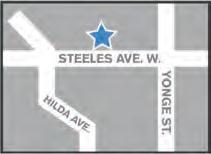
be consistent with Manita’s Ossington location, McGrenaghan says it won’t be identical.
“It’s not going to feel like a complete replica. We want it to feel like part of the Rosedale neighbourhood and fit well in the old historic building it’s in. It's still going to feel very, very Manita-like,” he says.
Complete with homemade remoulade, Manita's burger is known as one of the best in the city.
“The Rosedale Diner was an amazing neighbourhood restaurant, and we feel the best way to pay homage to its legacy is embracing that and recreate the feeling of an amazing neighbourhood restaurant that people can enjoy today.”
In late 2023, Toronto bid farewell to the Rosedale Diner, a beloved community fixture for over four decades. Established in 1981 by Dubi and Esti Filar, the family-owned eatery was known for its great food and sense of community. Celebrities such as Rush lead vocalist Geddy Lee were patrons.
While many of the details will
Capturing the essence of its Spanish namesake, Manita was founded in 2020 by Colin Tooke and Ian McGrenaghan of Grand Electric fame and Sam Lipson. Known for its eclectic menu, ranging from Mediterranean-inspired dishes to Canadian classics, it’s a place to grab a coffee in the morning, a mid-day meal, some groceries after work or dinner and a drink at night.
Although the restaurant on Yonge Street, north of Davenport, won't be open for a while, its secluded patio boasts a tranquil city garden vibe. It will undoubtedly serve as the perfect backdrop for enjoying the outdoors as patio season approaches. Manita Rosedale, slated to open in summer 2024, is situated at 1164 Yonge St.
—Jennifer Schembri

Paris is coming to Toronto courtesy of Bomou, an artisanal bakery set to tantalize Rosedale residents' taste buds with its exquisite pastries, chocolates and bread.
In 2020, during the pandemic, the modern Parisian café opened its first location at Bayview and Eglinton. Founded by sisters and co-owners Azar and Negar Sabzevari, the bakery thrived,despite a challenging start and temporary closure due to COVID-19 quarantine measures in Toronto, Negar Sabzevari studied in France with a dream of opening her own boulangerie-pâtisserie to rival those she experienced
abroad. Today, Bomou's signature products, including the pistachio croissant and selection of freshly baked baguettes, are considered some of the best in the city.
Located at 1075 Yonge St., Bomou's new outpost is getting ready to welcome Rosedale residents with French baking artistry. With traditional techniques and premium ingredients, Bomou's expansion is poised to make a significant impact in Rosedale. Notably, the area has been lacking in bakery options, making Bomou's arrival all the more exciting for local residents craving authentic and delicious
baked goods.
Although the shop is in its final stages of renovations, the anticipated opening date is set for the end of April. If the design is anything like the Leaside location, expect a stylish and minimalist space that draws the eye directly to prominent displays of breads and sweets.
“Every day, we flourish in our savoir-faire [know-how] and take pride in our food quality,” says Azar. “We are [continuing to] share our passion for traditional French bread, viennoiseries, pastries and chocolates with the people of Toronto.”
—Jennifer SchembriBao House brings the creative vision of a seasoned chef to life. Owned and operated by Master Lee, renowned for his passion for crafting affordable yet delicious dishes, the restaurant, located in North York, is swiftly gaining recognition in the neighbourhood.
Master Lee's story is as fascinating as the dishes he serves. Born in Taiwan in the 1950s, he experienced poverty and became involved in criminal activities during his youth. However, a soup dumpling shop owner provided him solace and guidance, igniting his passion for cooking and leading him on a journey of redemption and self-discovery.
Inspired by his personal journey, his Taiwanaise roots and a desire to offer accessible dining options to the community, Master Lee decided to open Bao House
The restaurant's concept is simple yet innovative: to provide generous portions of Chinese cuisine meant for sharing at affordable prices.
“Chef Lee firmly believes that the true essence of food lies in its ability to bring people together and create shared experiences. By making our dishes affordable, we can spread the joy of flavourful cuisine to as many people as possible,” says a restaurant representative. “We want everyone to have the opportunity to savour the best tastes without worrying about exorbitant costs.”
Bao House specializes in xiao long bao, offering traditional pork-filled XLB alongside innovative variations, like Indian curry, Sichuan hotpot, Korean kimchi and Thai sweet and sour XLB.
Bao House is located at 5336 Yonge St.






From chic and contemporary to family-friendly, here are the best restaurants in Thornhill to keep on your radar.
1. The Michelin star
Led by executive chef and owner John-Vincent Troiano and chef So Sakata, Frilu’s tasting menu, a rare find in the area, features smoked elements, game meats and meticulously crafted sauces. They utilize high-quality ingredients sourced from their own Willowolf Farm, coupled with a Japanese influence. 7713 Yonge St.
2. The sushi king
24-carat gold-gilded doorway from New York’s St. Regis Hotel and 18th-century stained-glass panels. Known for its quality cuisine, the Octagon serves USDA Prime beef aged for at least 30 days, ensuring excellent flavour. 7529 Yonge St.
4. The eclectic eatery
Frilu's John-Vincent Troiano trained at Copenhagen's iconic Noma.
At chef Daeu Kim’s Yorokobi Japanese Restaurant, freshness is key. Serving some of the best sushi in the city, the menu boasts a variety of unique specialty rolls and cooked dishes. Beyond the cuisine, the modern, woody interior creates a welcoming atmosphere, complemented by beautiful Japanese artwork adorning the walls. 7771 Yonge St.
3. The premium steak house
The Octagon has been a local favourite for over 40 years. A lavish renovation adorned the space with opulent features including a
In 1995, three young entrepreneurs opened Terra restaurant north of the core. Now, after 30 years, Terra has become a renowned name in fine dining. With whiteglove service, elegant decor and a curated menu by executive chef Stephen Perrin, Terra offers a memorable dining experience. 8199 Yonge St.
5. The BBQ joint
Holy Smoke offers a heavenly experience reminiscent of a religious gathering. Its kitschy-cool decor features images of Moses holding up a brisket and other religious motifs. True to its central Texas roots, Holy Smoke’s menu focuses on the “Texas trinity” of brisket, turkey and pork ribs, along with jalapeno sausage and pulled pork and classic sides.
8123 Yonge St.
—Jennifer Schembri

The Company We Keep is not just your average café — it's a multifaceted establishment born from the vision of industry mavens Jenn Hornak and Nika Mistruzzi. Drawing on their expertise in sommelier work and baking, they've created a space that effortlessly shifts from pantry and café to wine bar and restaurant, all while serving as a vibrant venue for pop-up events. Walking into the space is like stepping into a cosy kitchen with friends. Hornak and Mistruzzi wanted a place where guests could relax, connect and enjoy homemade food, and they've done just that. From Mistruzzi's
delicious pies made with seasonal fruits to Hornak's thoughtfully chosen wines, everything reflects a commitment to quality and authenticity.
But it's not just about the food — it's about the experience. The café buzzes with life, hosting everything from culinary pop-ups to live music nights. And with partnerships with local suppliers and industry friends, every product on the menu is a testament to the power of collaboration.
“We both wanted to open a café that fostered a sense of creativity and community,” say the owners.
The evening program en-
hances the experience with wine flights, cider, beer and cocktails, complemented by small plates of charcuterie and savoury snacks.
Looking ahead, guests can expect even more goodness on the horizon. With plans to expand their patio space, enhance their menu offerings and host a variety of events and collaborations, this café’s journey is just beginning.
In a world of fast dining, The Company We Keep offers a refreshing reminder: good food and company make life meaningful.
Find it at 634 St. Clair Ave. W.
—Jennifer SchembriLocated in Toronto's Greektown neighbourhood, Azura offers a unique dining experience that blends innovation with the rich flavours of the Mediterranean.
Under the leadership of executive chef and partner Adam Ryan, Azura introduces a distinctive chef's choice, blind tasting menu, inviting diners to embark on a multi-sensory exploration of Mediterranean cuisine.
“In creating Azura, we saw an opportunity to bring something a bit different to Toronto. We’re proud to utilize locally sourced products in combination with traditional ingredients and techniques to build these complex Mediterranean flavours.”
The menu features an eight- to 10-course classic tasting option or a more compact 4- to 6-course selection. Priced at $128 (classic) and $72 (petite) per person, it’s accompanied by optional wine pair-
ings and spirit-free cocktail flights, providing guests with a customizable dining experience.
Guests are greeted with an array of inventive canapés, such as a French panisse topped with kohlrabi and ambrosia apple labneh, Osetra sturgeon caviar, and Greek bottarga of red mullet row preserved in beeswax.
Signature dishes include the shawarma spiced halibut, where East Coast halibut meets an Egyptian spice blend and Spanish piquillo peppers, and the Ibérico Secreto, a marinated Spanish pork cut served with pink radicchio and fennel confit.
The restaurant’s decor features plush velvet banquettes and Grecian pottery, adding elegance to its intimate setting. In warmer months, its large wooden doors open onto the Danforth, offering an inviting indoor-outdoor dining experience.
Azura is located at 162 Danforth Ave. —JS





































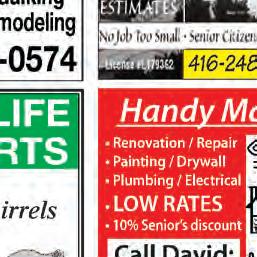



































































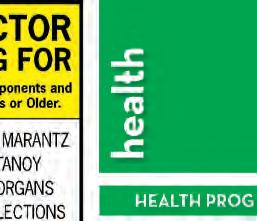




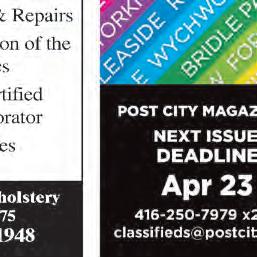






40 years ago, MuchMusic was born, and it changed everything




Some 40 years ago this year, before the Internet, before Instagram and TikTok, cool in Canada was defined by Toronto’s MuchMusic. Situated on Queen West, the TV station not only rivalled but bested America’s MTV. Established in the early 1980s, it quickly became synonymous with the vibrant Queen West scene. Its iconic building, with a truck burst through its wall, became emblematic of its rebellious spirit. Inside, MuchMusic fostered a unique environment for music enthusiasts, featuring innovative programming from Speaker's Corner where







Barenaked Ladies first appeared to Electric Circus and The Wedge, where individuals could voice their opinions in front of a camera, dance their hearts out and discover the best new music from the likes of U2, No Doubt and Red Hot Chilli Peppers to name a few. The station was propelled by a cadre of charismatic VJs, including Erica Ehm, J. D. Roberts, Sook Y in L ee, Master T, and Terry David Mulligan who shaped the channel's identity That MuchMusic magic might be gone, but the memories remain of a time when Queen West cool ruled.







